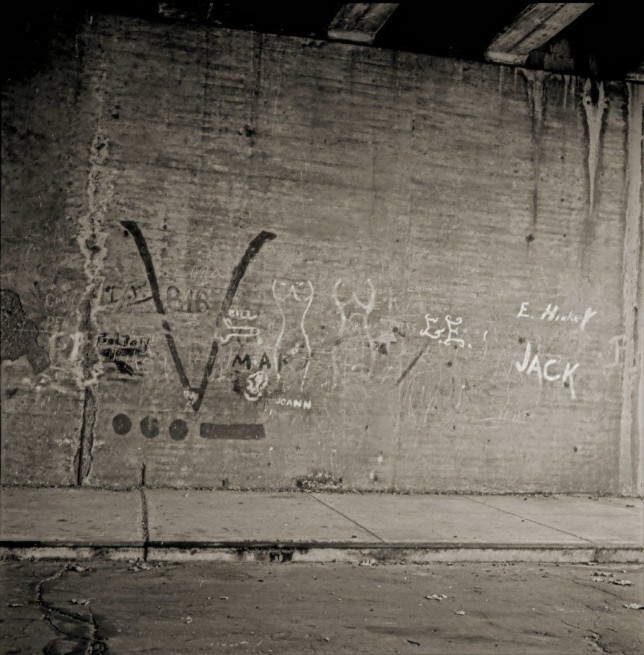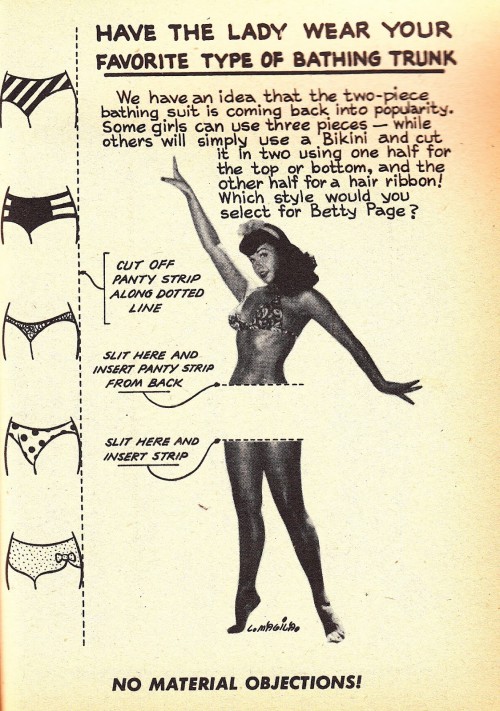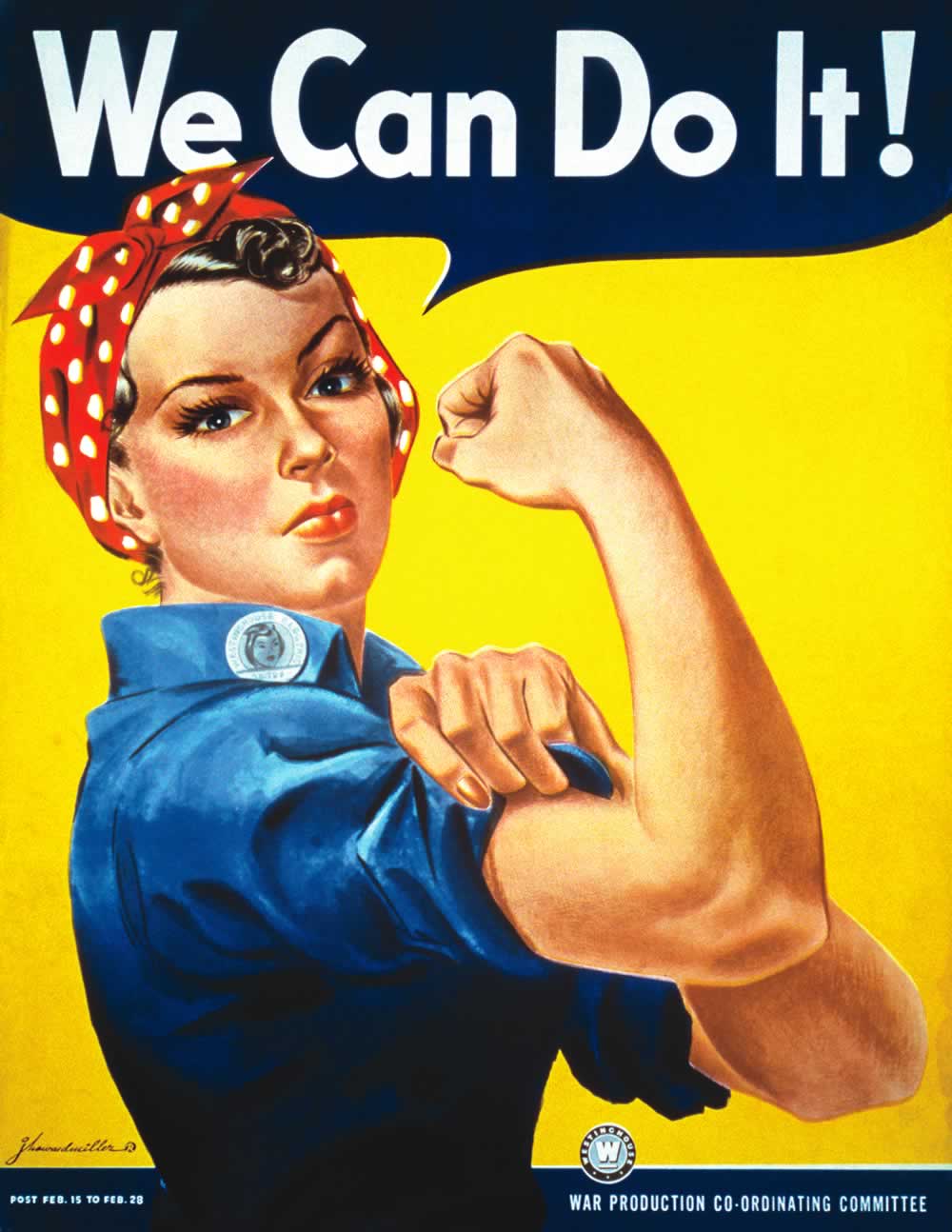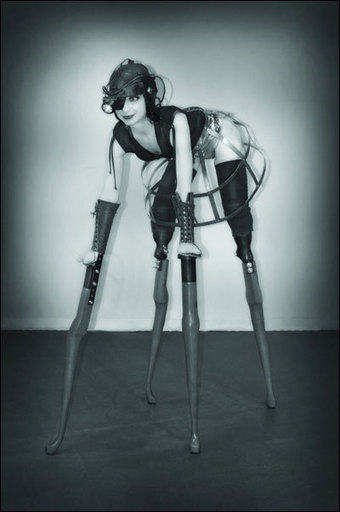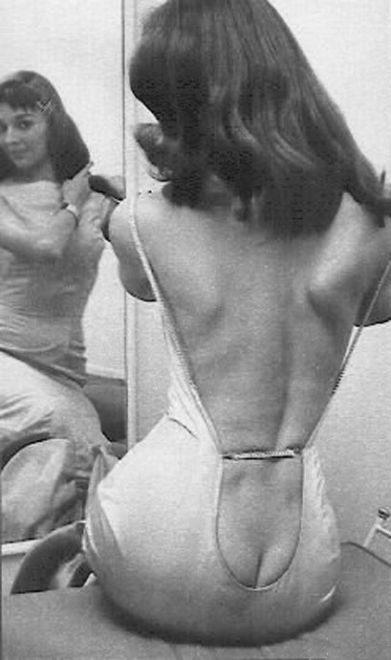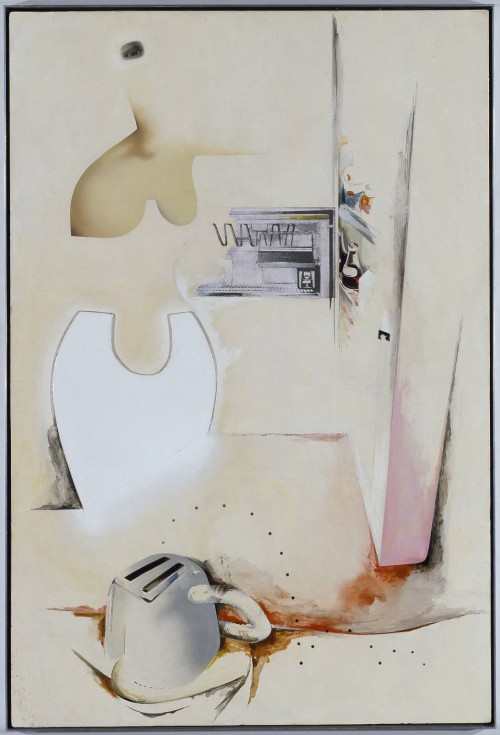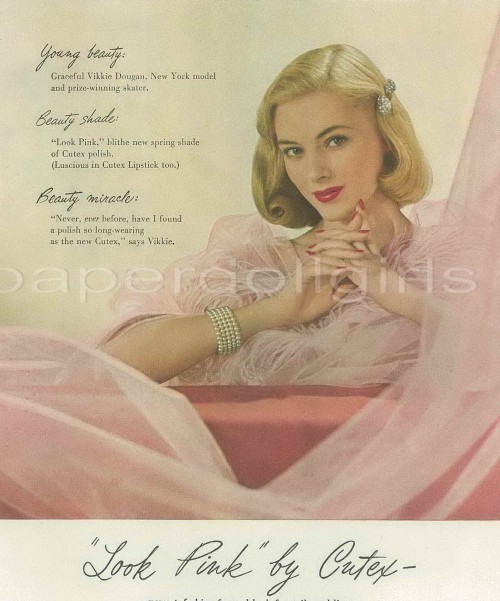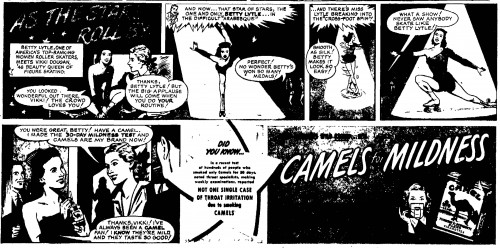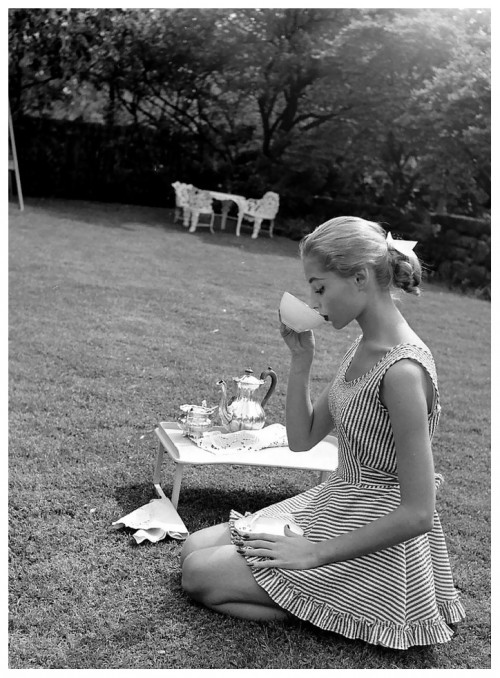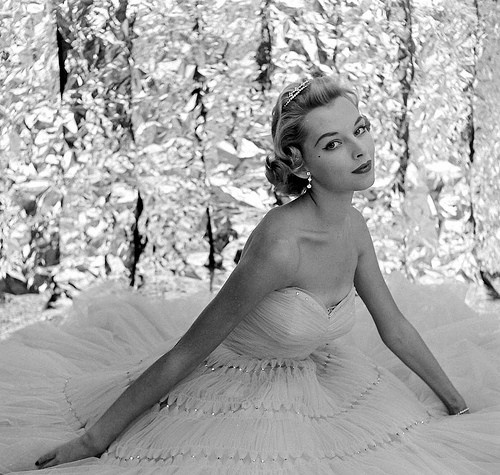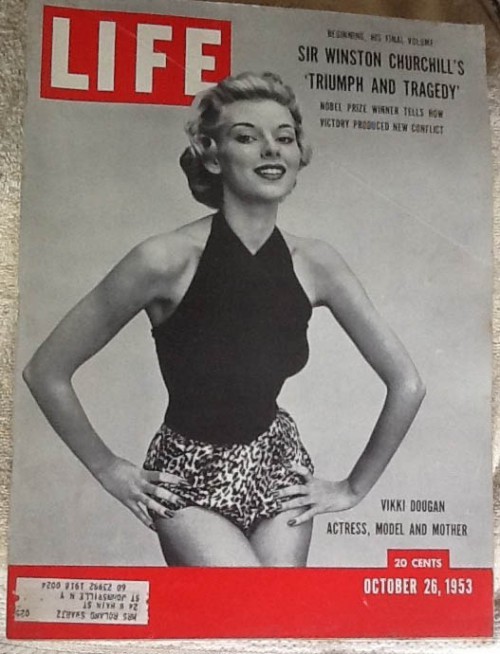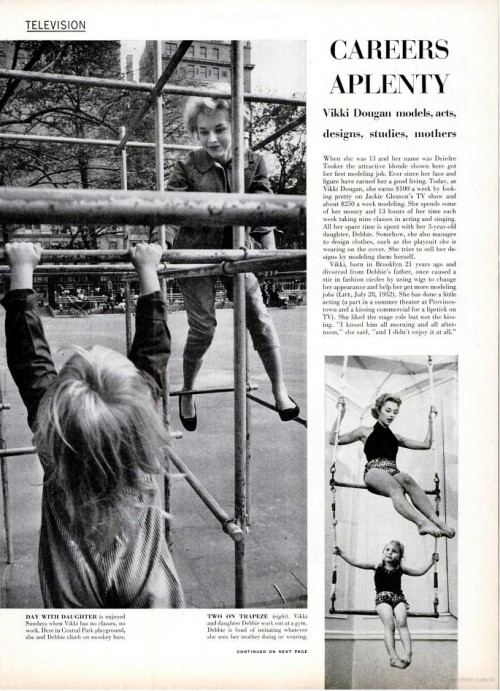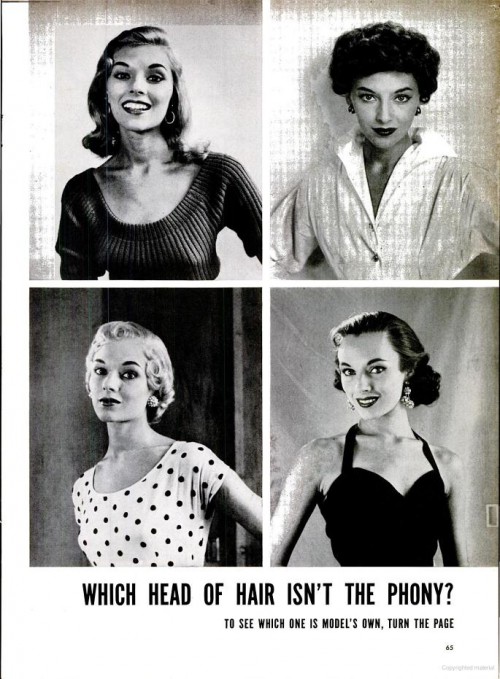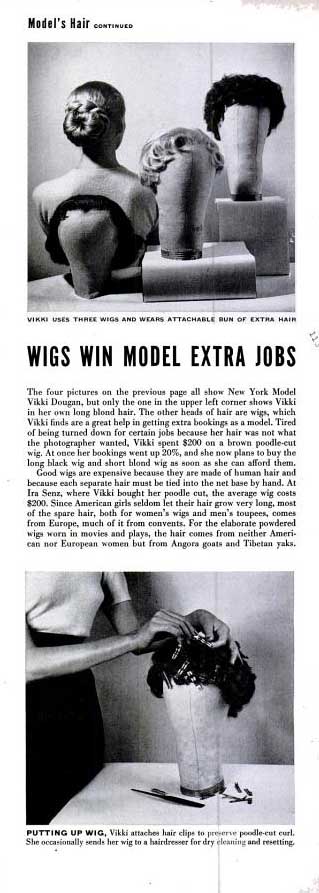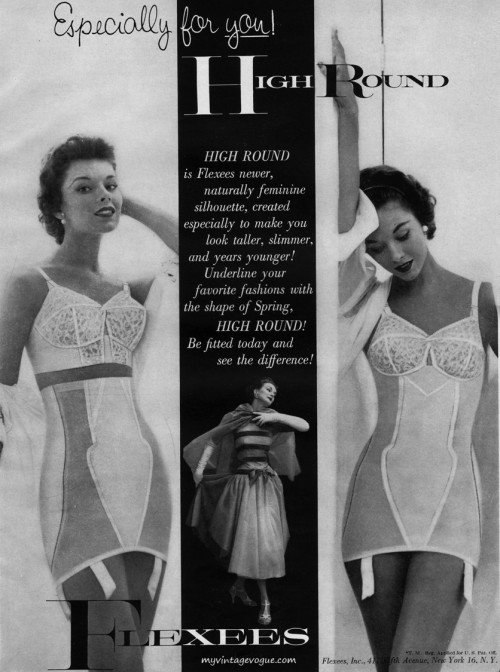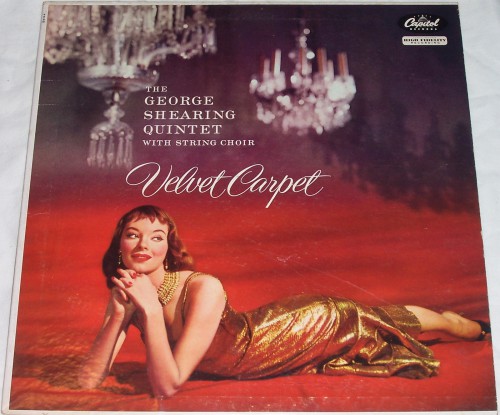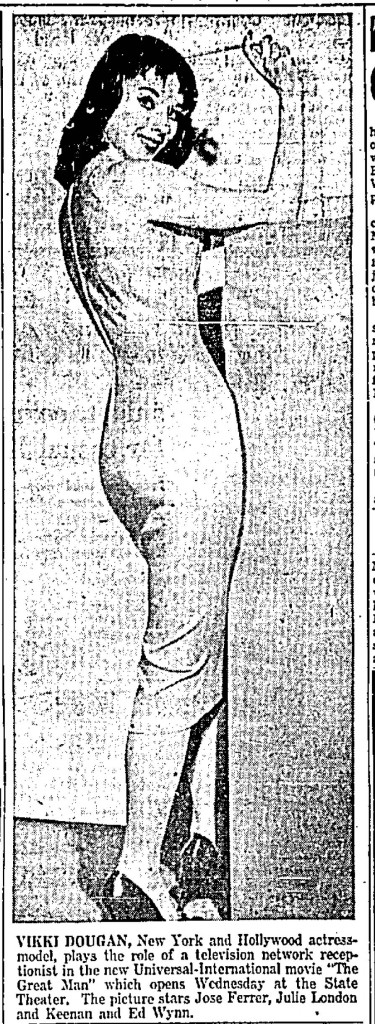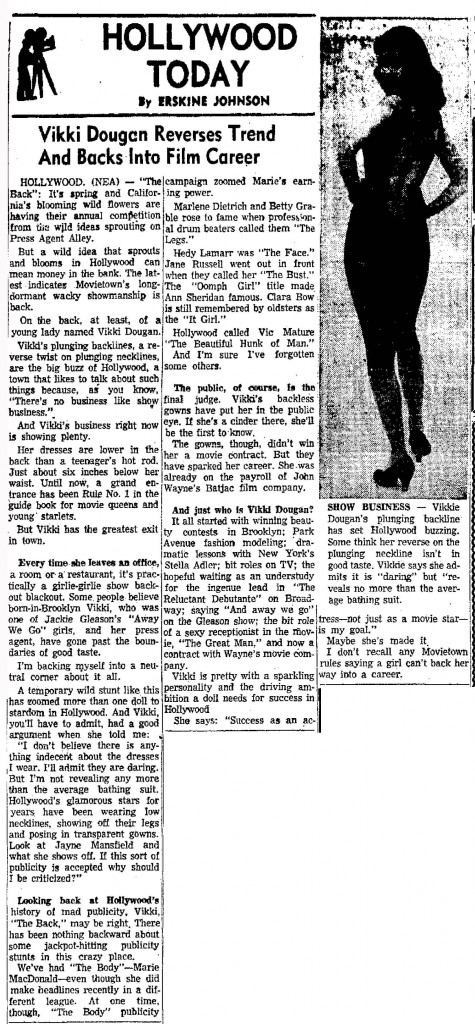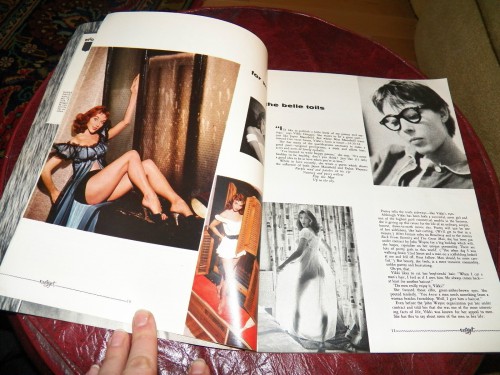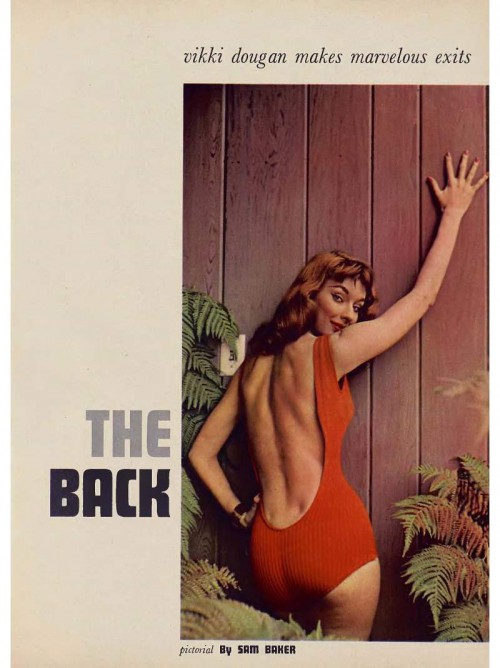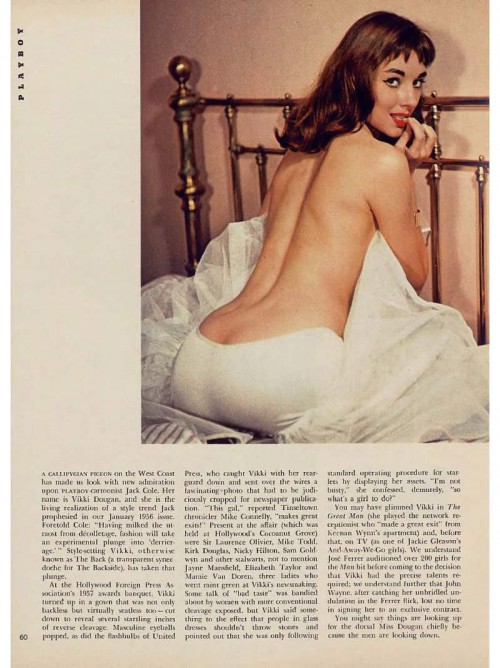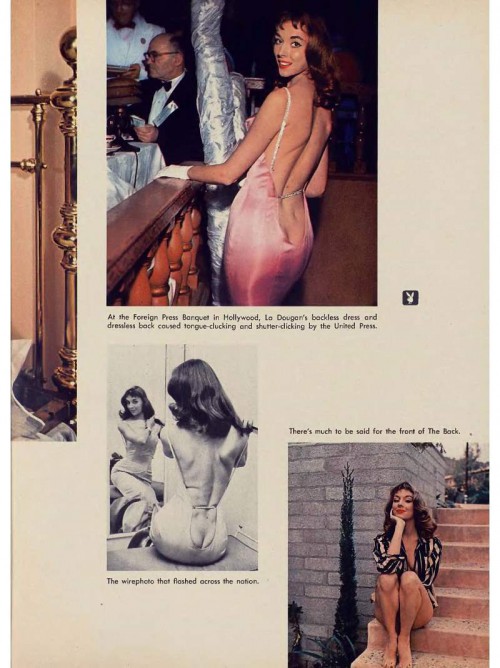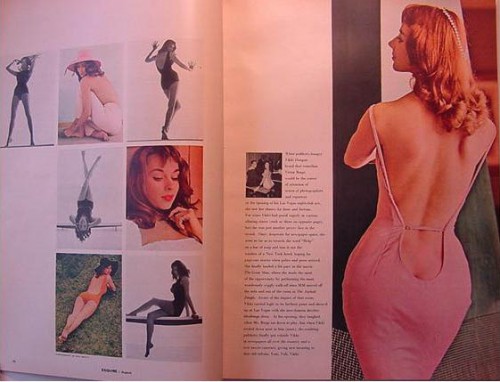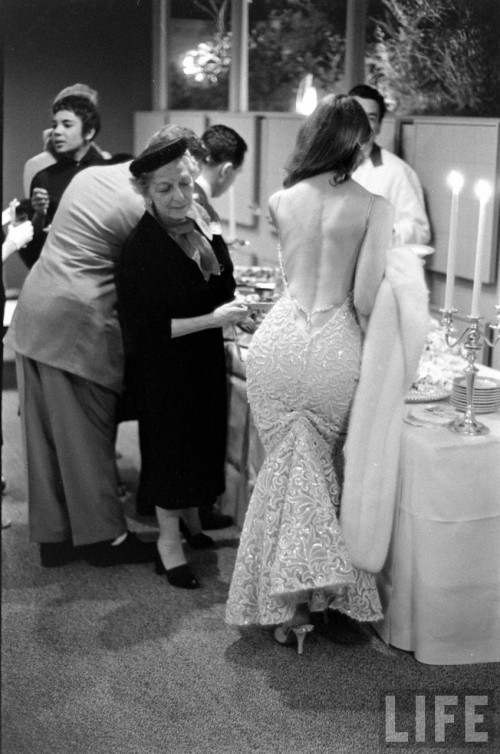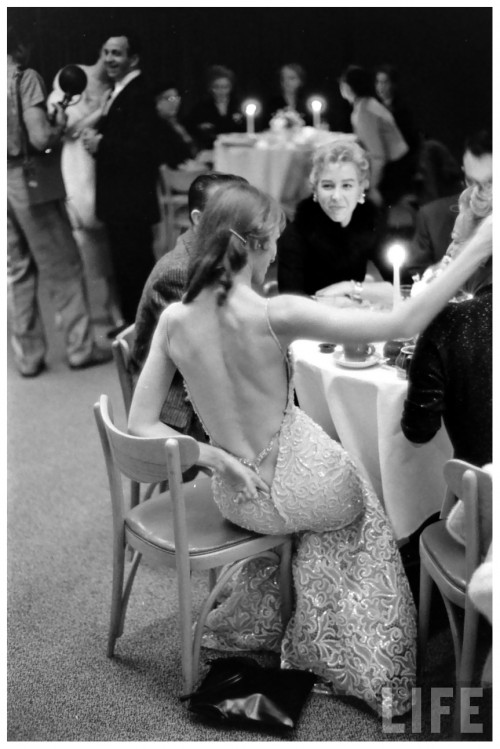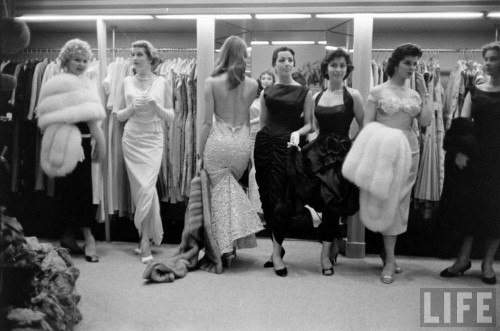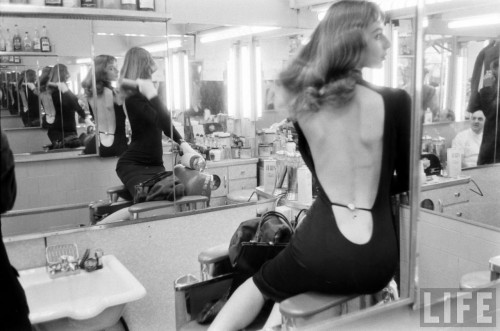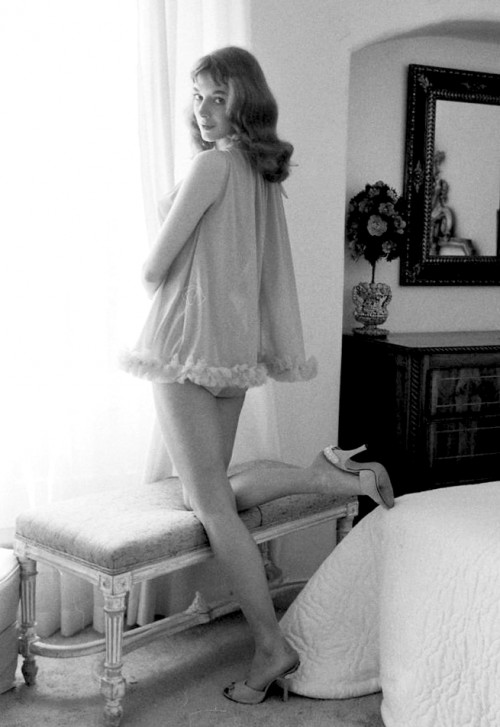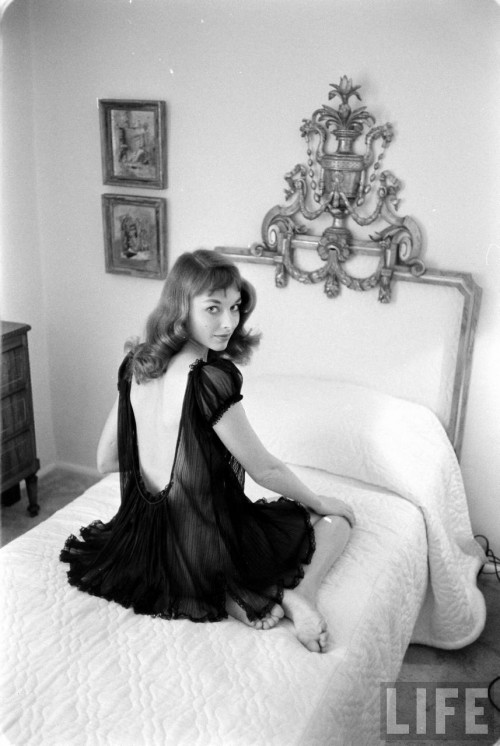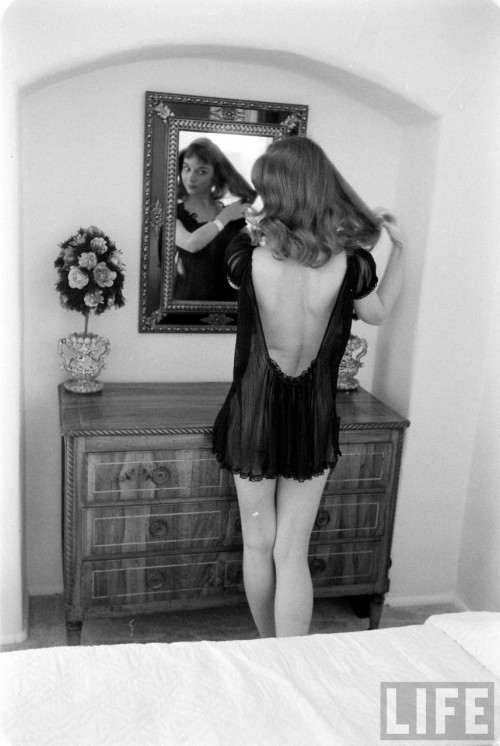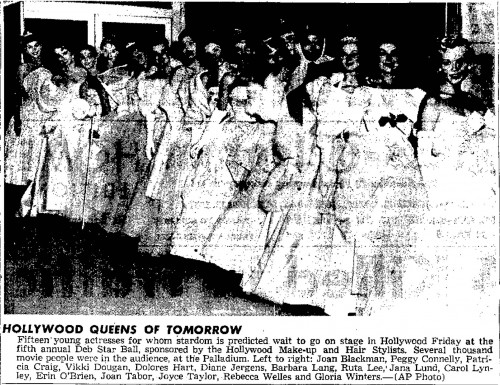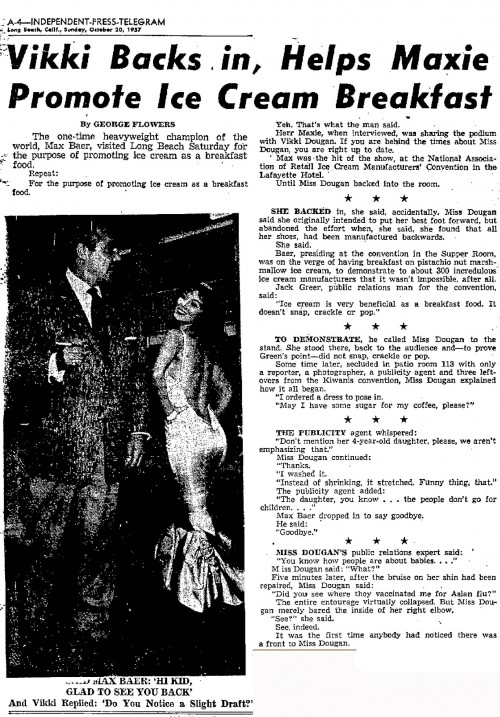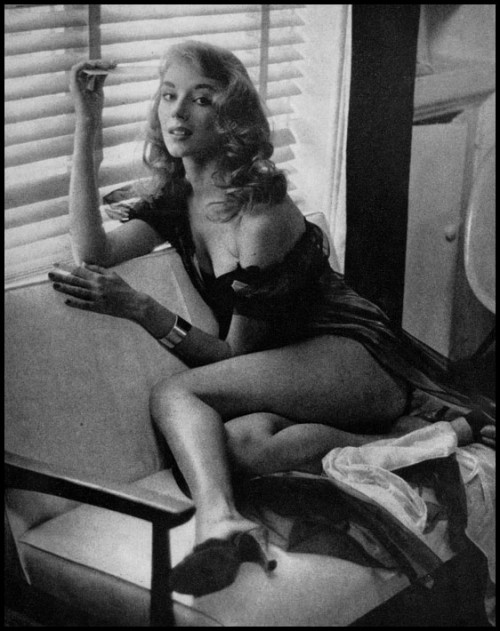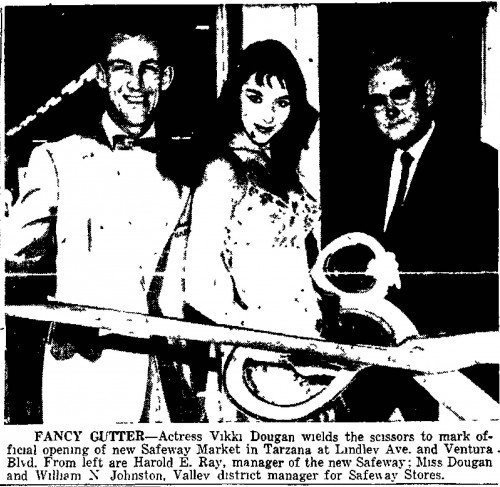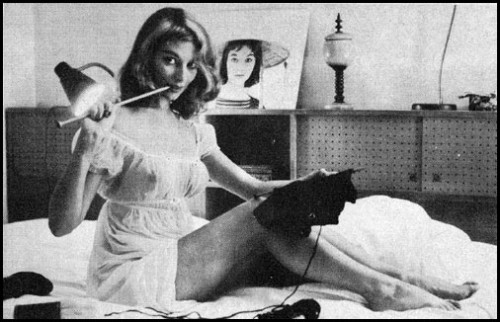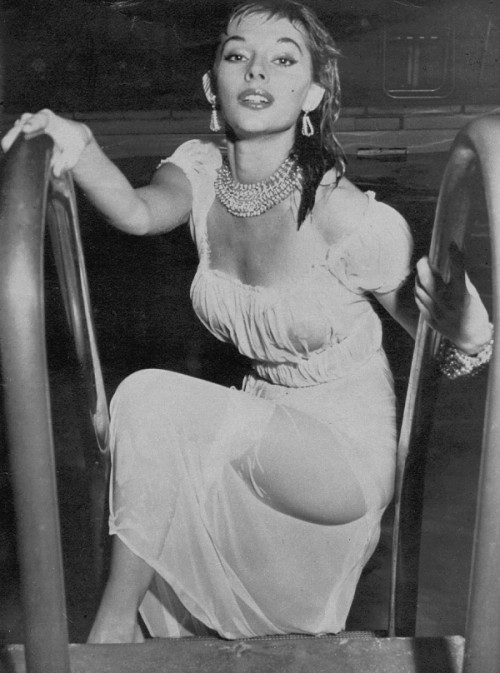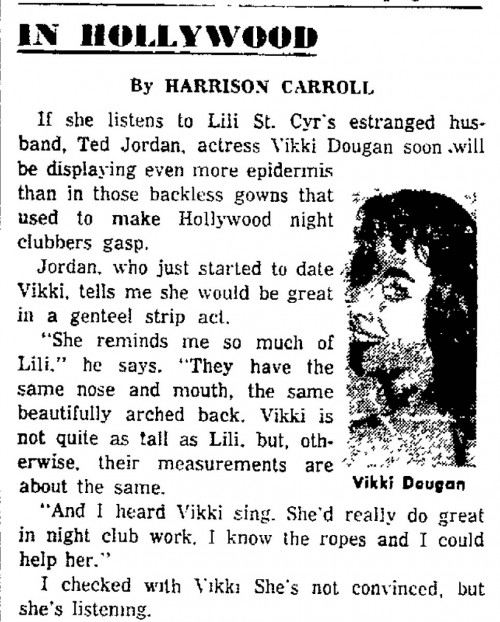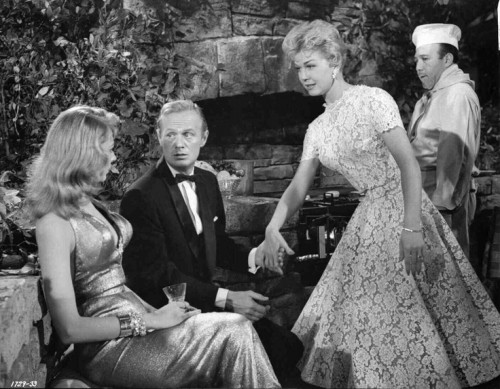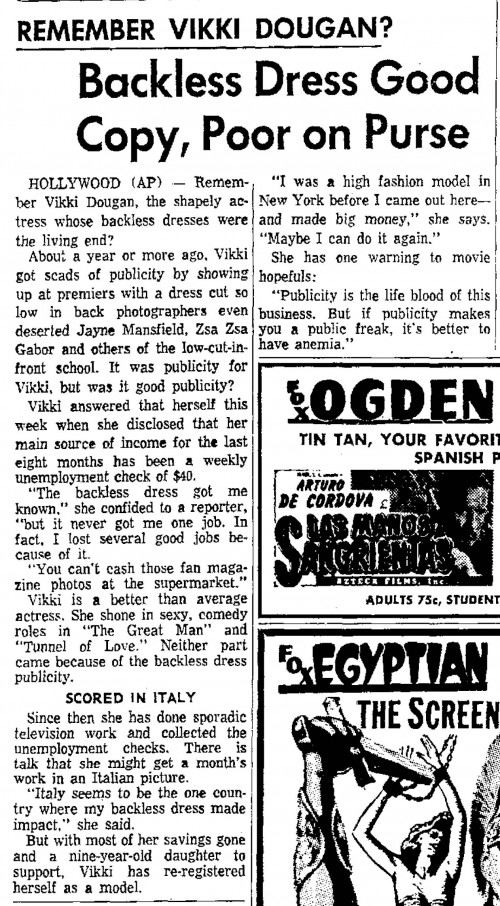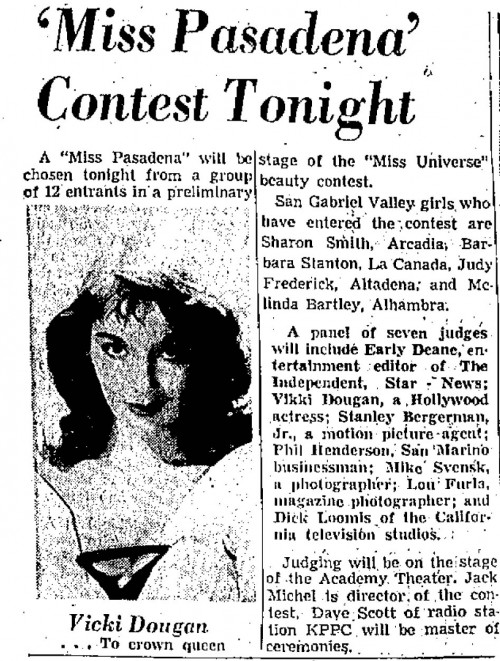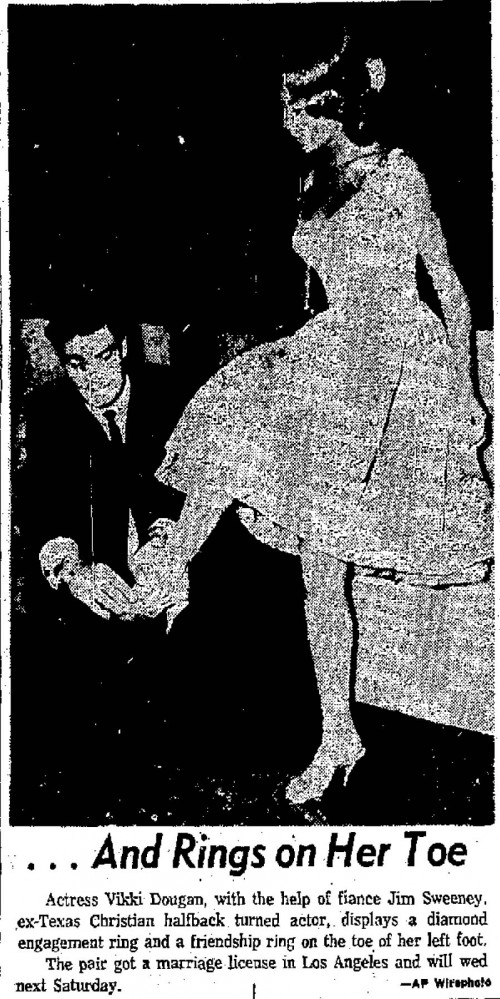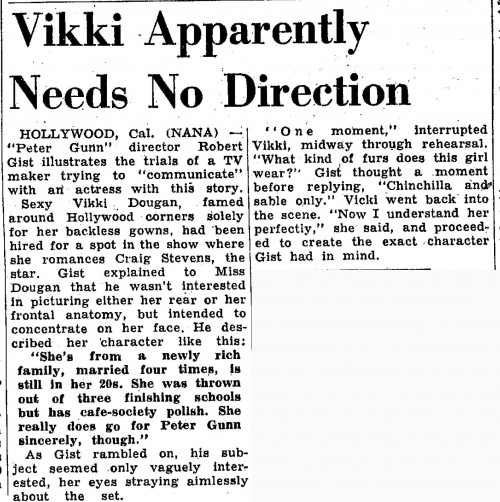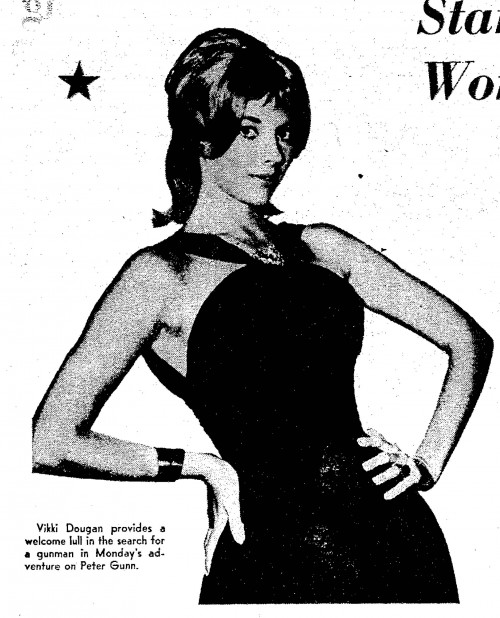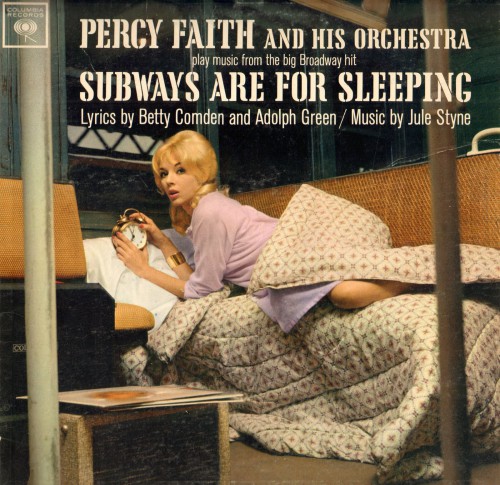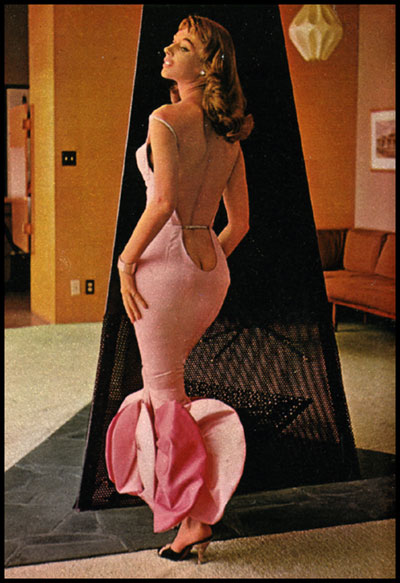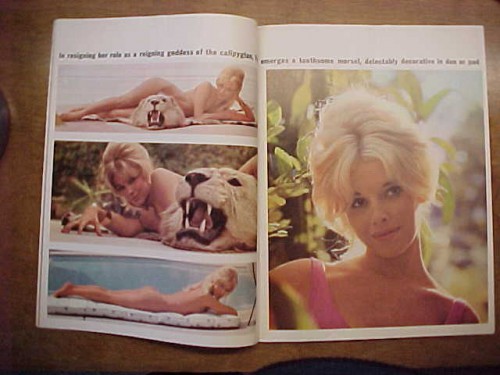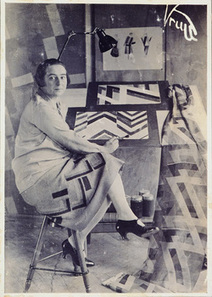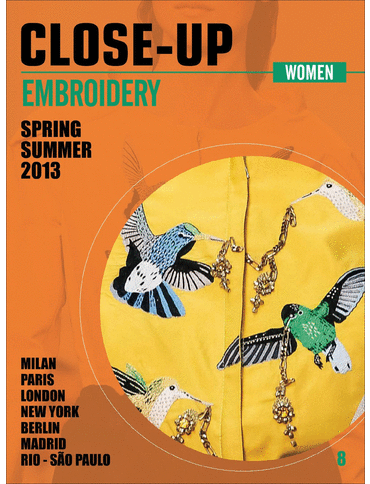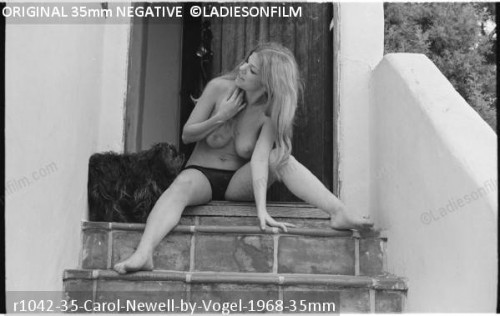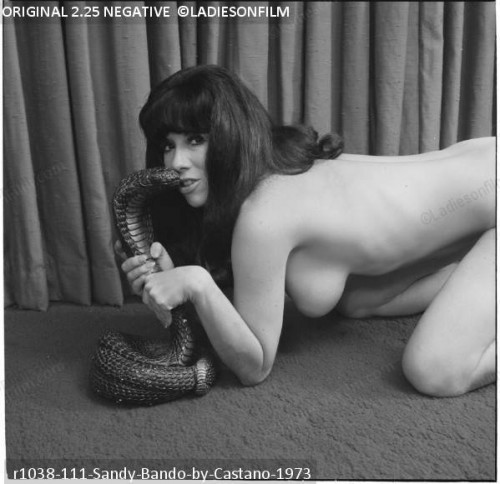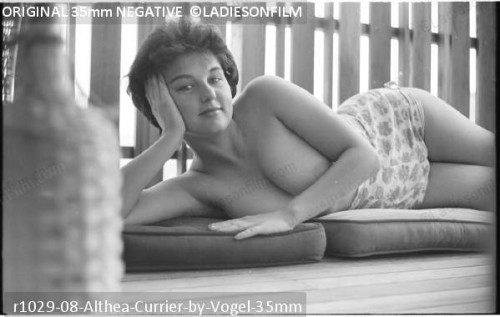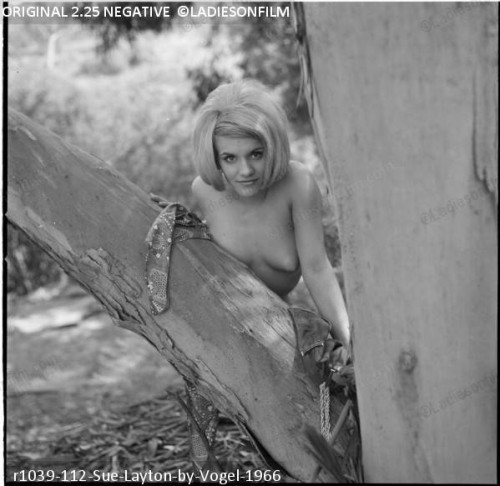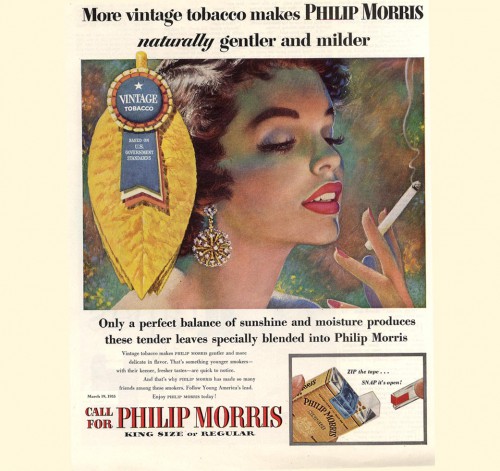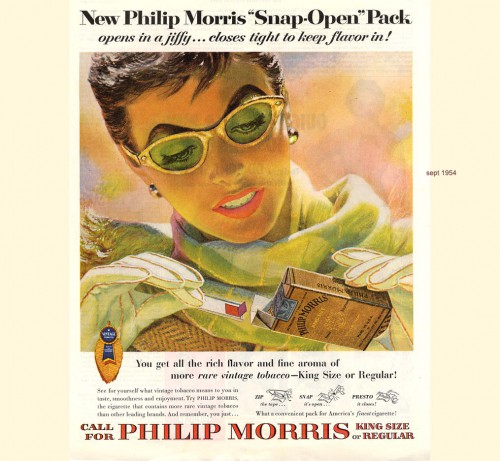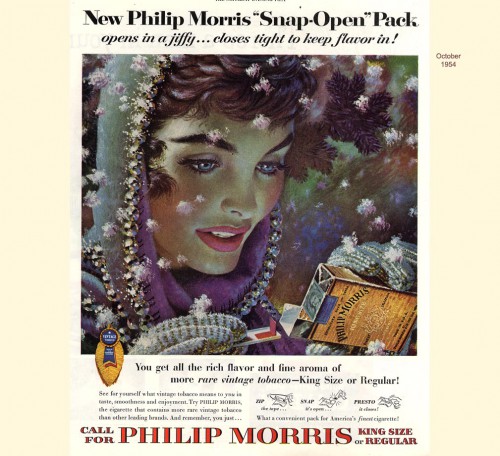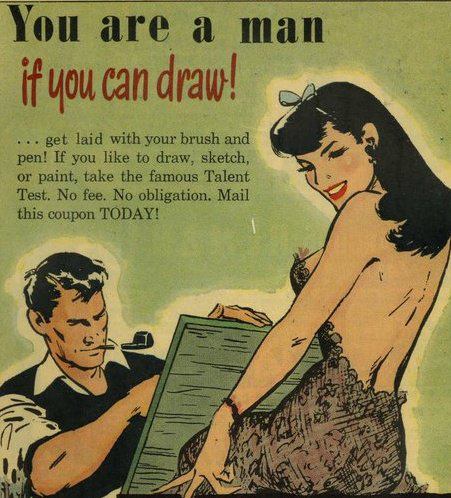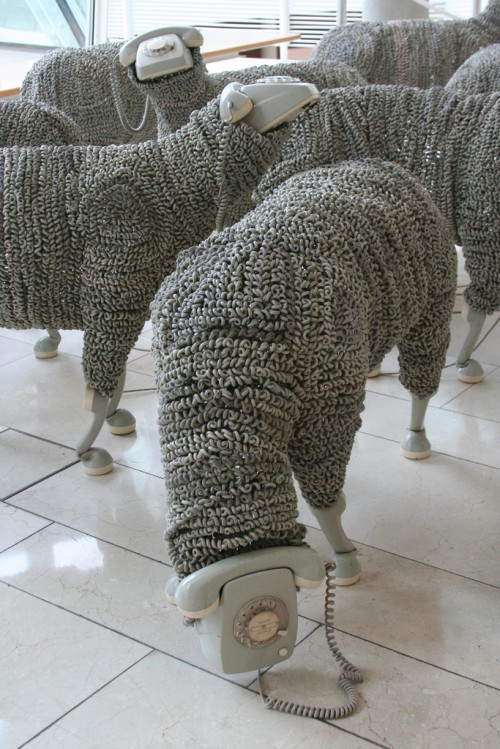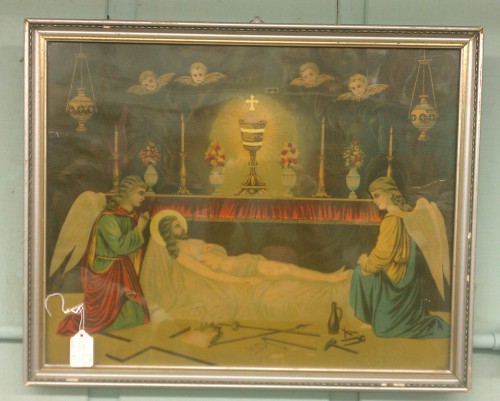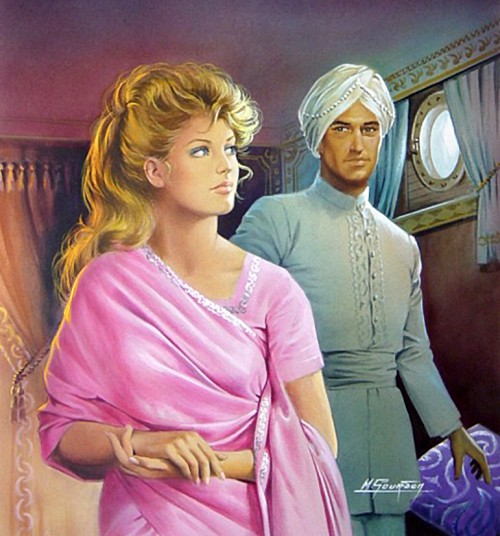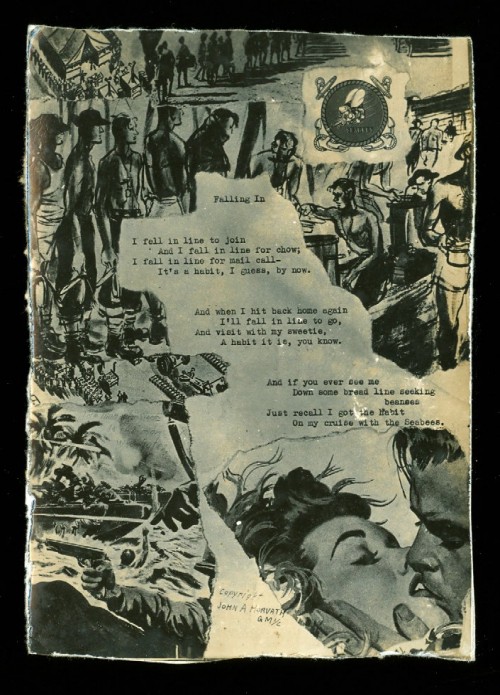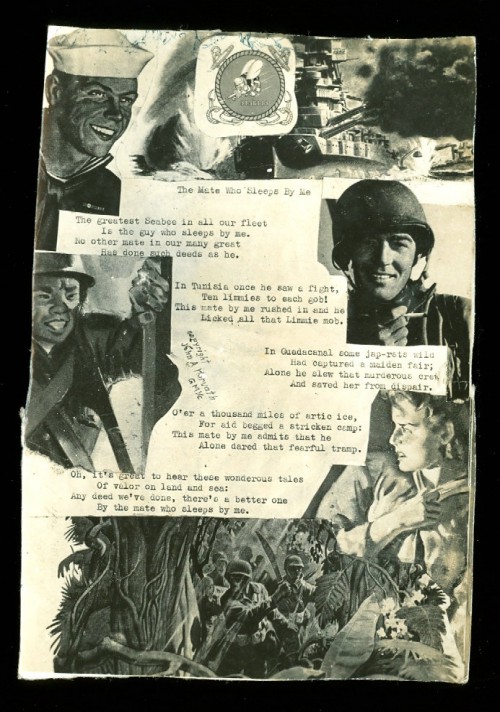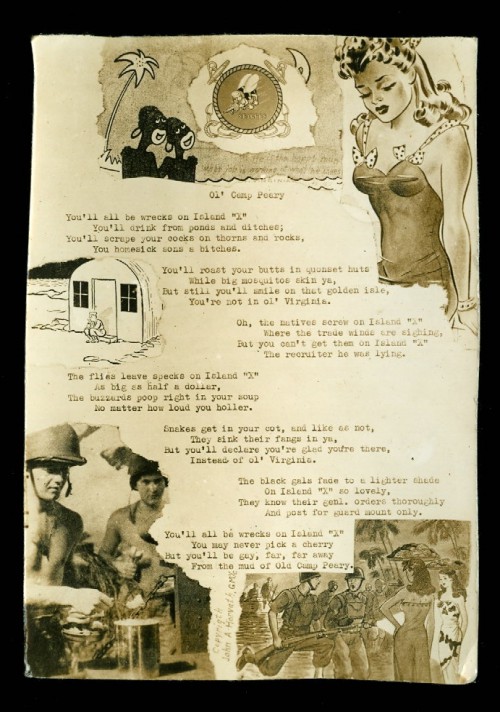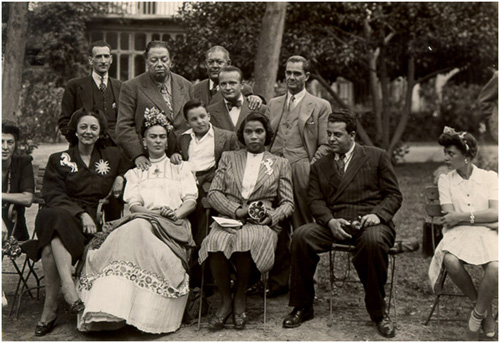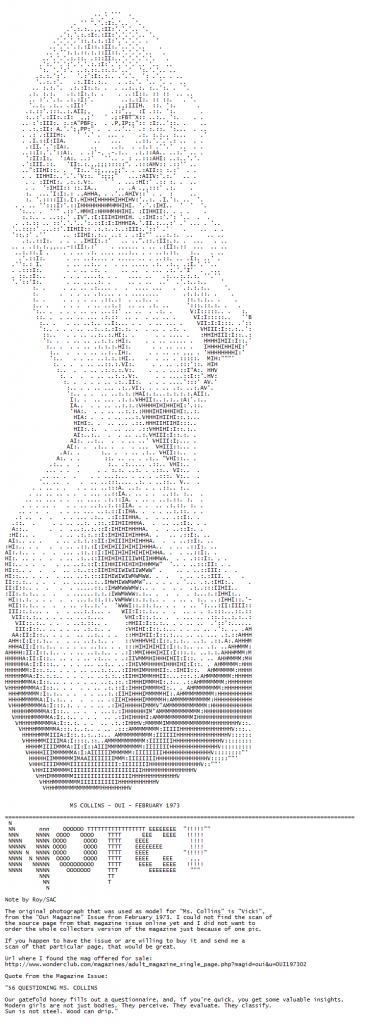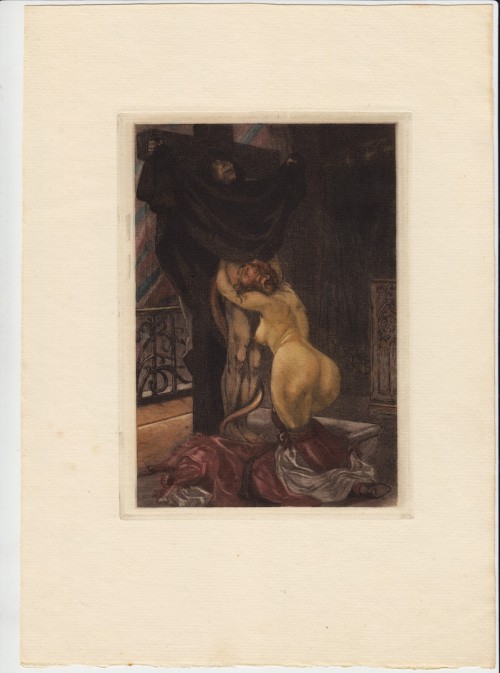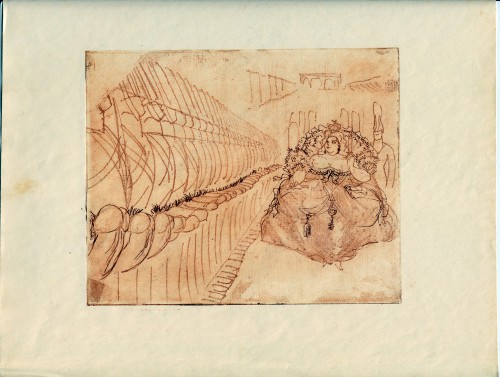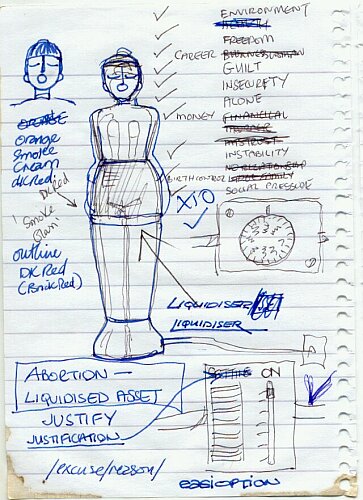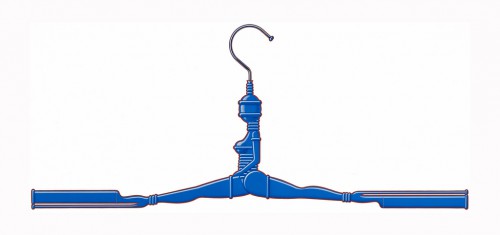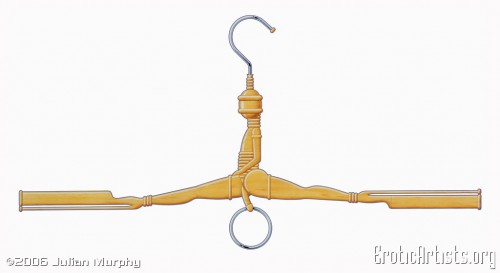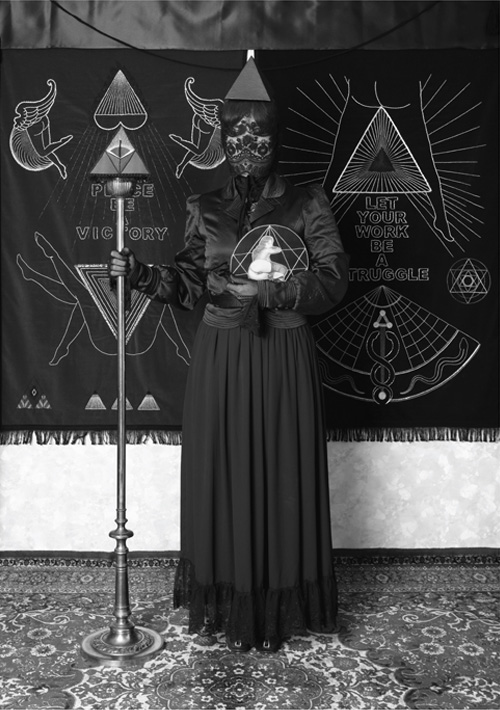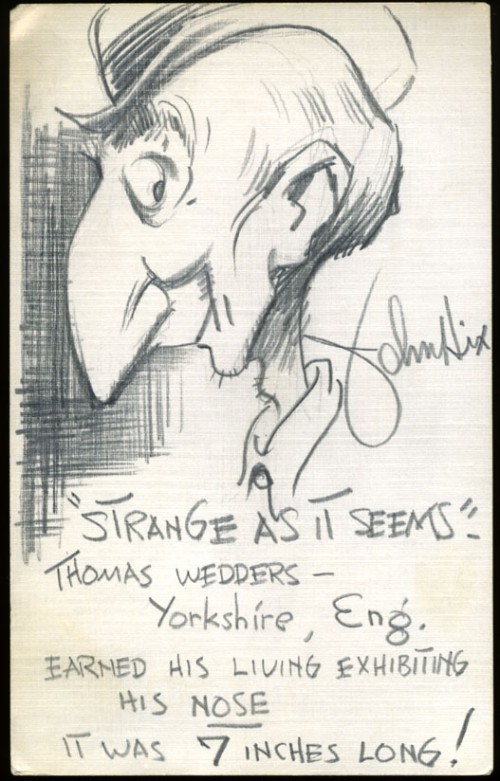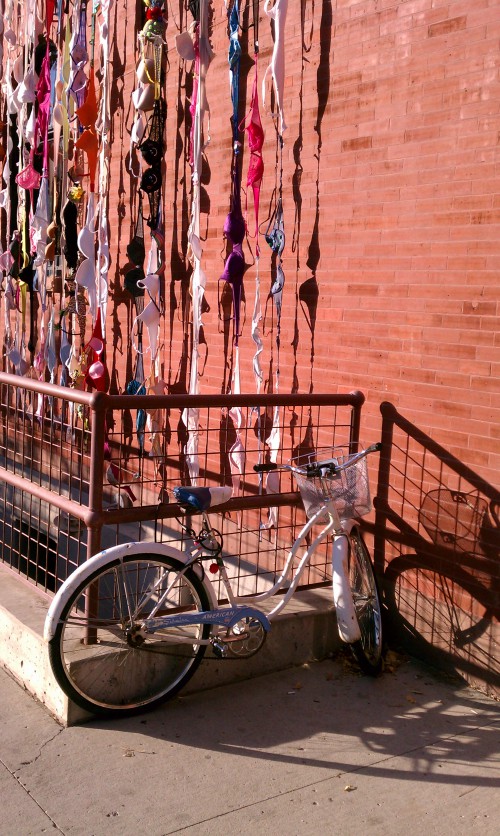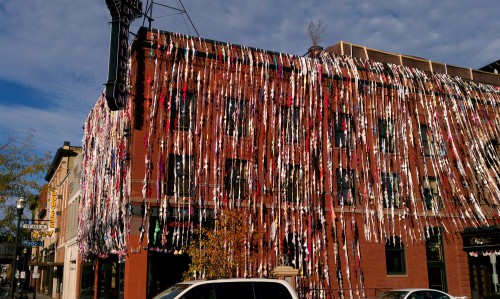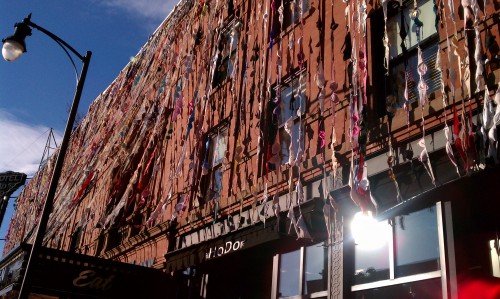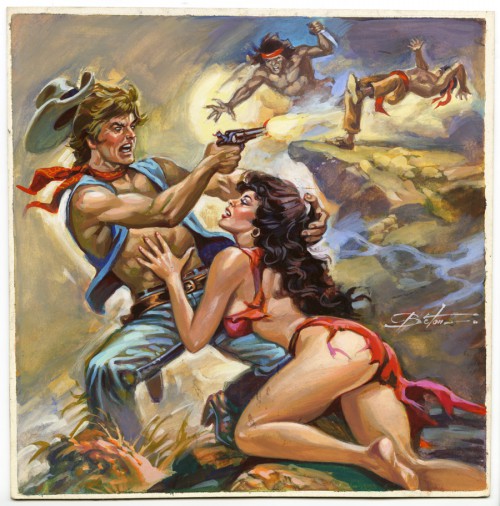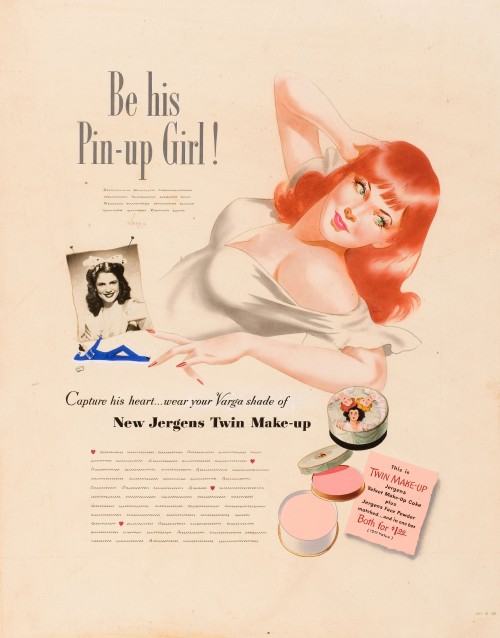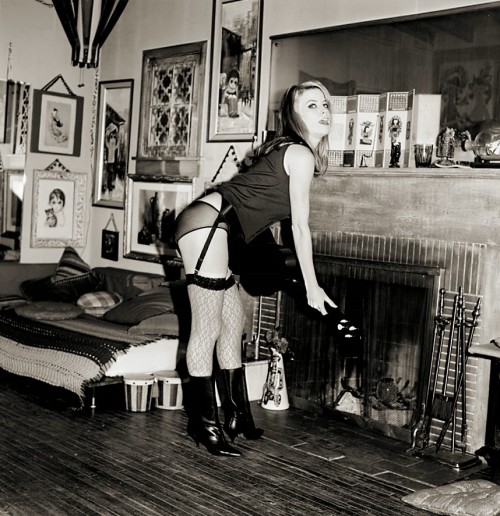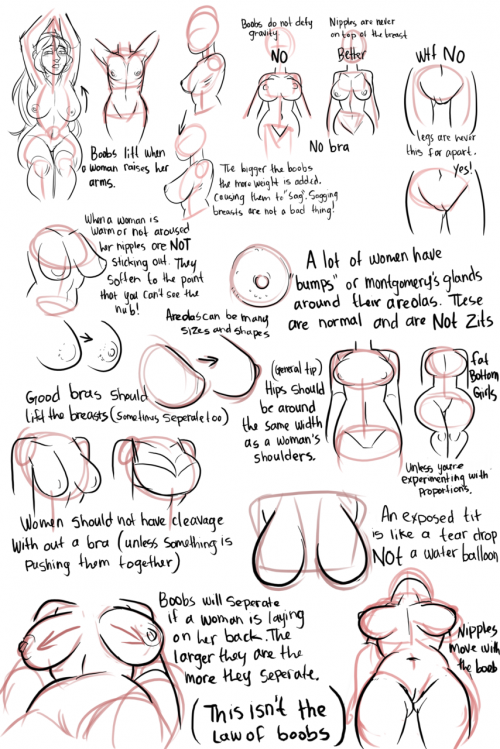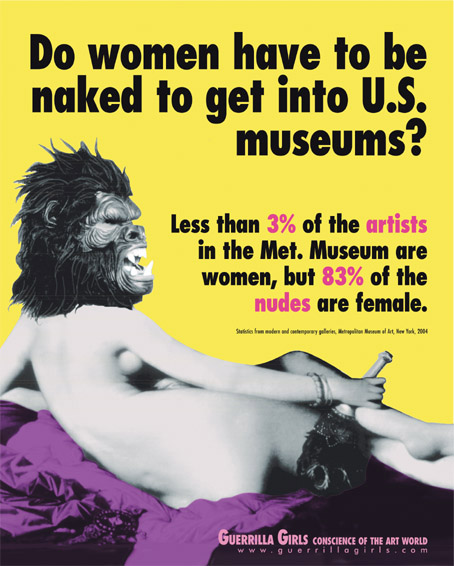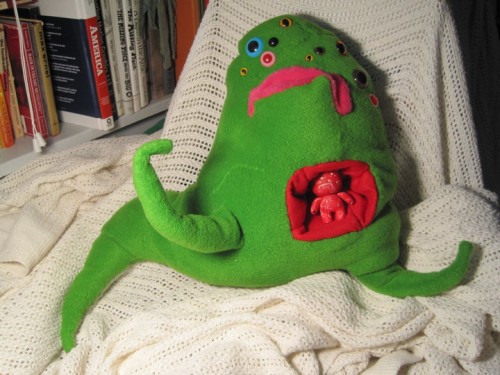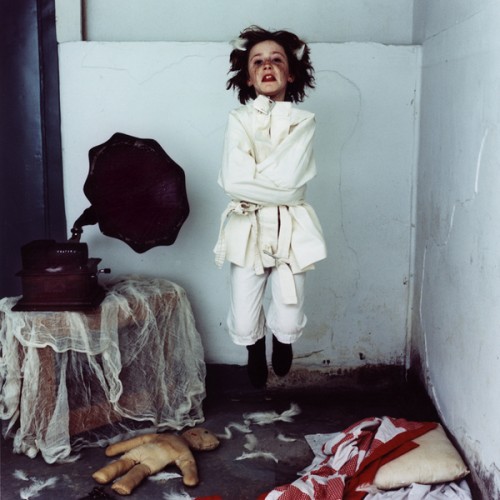Just in case you thought the 1950s were such a pure time… Via.
Category: Artful Dodger
Art – including that which you shouldn’t dodge, but ought to buy!
Bettie Page & Other Paper Pinup Fantasies
There obviously some errors in the text — the misspelling of Bettie Page as “Betty Page” and frankly, I am completely lost in the description of this paper doll for playboys…
However, this post is not about the text or even the fact that you almost expect one of the options to be a smooth Barbie-doll-esque image to make Bettie go bottomless; it’s about the art of Lou Magila.
Jim Linderman of Vintage Sleaze doesn’t like this artist — or at least the guys’ works. But I have to vehemently disagree.
As a woman, I often find the most real thing about a man’s fantasy is the image of a pinup or media babe inserted into some sketchy scenario. Like the pornos with the world’s luckiest pizza delivery dudes, the scene isn’t as important as just getting to the babe.
Yes, a lot of attention is being brought to the fact that the women in the photos do not even look like the women who posed for them; but the only thing faker than the photoshoped objects of desire are the scenes and situations in which men place the perfected images of women. Is there anything wrong with that? No; they are fantasies after all. (Expecting them to be real is another matter entirely, and one at the very definition of “sanity”.)
So what’s wrong with cartoons, illustrations, comics that capture that luscious and ludicrous point of view? There’s something rather charming about the obviously juvenile approach to just sticking the woman into the simple bare lines. It makes me feel like the artist was aware of how simplistic fantasies are. I don’t know Magila; maybe he was self aware, maybe not. But like a lot of art, you just look at it and get impressions. My impression is that this artist was aware.
Did Magila rip-off other artists? Maybe he or the publisher paid for the rights; maybe not. Maybe, like the altered artists, digital artists, bloggers,etc. of today, artist and publisher alike just figured if they had their hands on something that meant it was in the public domain. Or perhaps they felt that there were enough changes to defend Maglia’s work as derivative. So far, the answers to those intellectual property rights are as unclear as the artist’s level of awareness of the simplicity of male fantasies.
I hope Linderman continues to suss things out.
Lisa Bufano: Dancer/Shapeshifter
“I’m a shapeshifter… I explore the different forms my body can take using different mediums.” – Lisa Bufano. Photo by Gerhard Aba.
Lisa Bufano is a performance artist whose work incorporates elements of doll-making, animation, and dance. Bufano was a competitive gymnast as a child and a go-go dancer in college before she lost her lower legs and all her fingers due to a staphylococcus bacterial infection at the age of 21. Shortly after this occurred, Bufano went on to study stop-motion animation and sculpture at the School of the Museum of Fine Arts in Boston.
See on coilhouse.net
Looking Back At Vikki “The Back” Dougan (A Biography)
Collecting vintage smut, as I do, I know who Vikki Dougan is; but I’ve been surprised a number of times by both the lack of recognition this iconic beauty has and the lack of information about her. So, ever obsessed as usual, I set out to correct the situation.
Vikki Dougan: you may not recognize her from the front, but you likely recognize her backside — hence her nickname, “The Back”.
In Persistent Pop (July 21, 1974), John Russel writes of how inspirational images of Vikki Dougan were to English pop artists:
A particular prominence was assigned, for instance, to ads which featured a young actress named Vikki Dougan. In memoirs of the period, individual ads featuring Miss Dougan are traced from house to house in ways that recall the hunt for a respectable provenance which plays so large a part in the authentication of Old Master paintings. Of an Esquire photograph of Miss Dougan, Richard Hamilton remembers: “I first saw it decorating a wall in [Alison and Peter] Smithson’s home. I gained my own copy from a student’s pinboard in the interior-design department of the Royal College of Art. Lawrence Alloway gave me the data on her; the photograph had impressed him sufficiently to make him regard it as a file-worthy document. It turned up again recently as one of a group of pin-ups in a painting by Peter Phillips.”
Her images were not only collected by English pop artists, but even inspired works, such as Richard Hamilton’s $he (1958-61).
This biography attempts to fill in some of the blanks about Vikki Dougan.
Before she earned the notorious nickname (and a plethora of puns), Vikki Dougan was born Edith Tooker in New York in 1929, to her parents Wilber and Mary (nee Dougan) Tooker. Legend says that in 1946, at the age of 16, she becomes both a Miss Rheingold finalist (but is disqualified for being underage) and the wife of a William Symons, the owner of a local photo studio.
Vikki’s big break came in 1948, when she (as Vikki Stappers Dougan) won the eighth annual New York Skate Queen competition. In promoting the ninth annual event, the following was mentioned in Billboard (April 2, 1949):
The purpose of the event, a joint promotion of Empire and The New York Journal-American, is to select an ideal girl roller skater and glorify her for a year. Judging will be based on charm, beauty and personality, with no points whatsoever for skating skill. Contestants must only appear on skates. …Professional skaters models and actresses are banned.
(Vikki, as Queen, and finalists followed up in 1949 by heading the “first ever” fashion show, sponsored by the Roller Skating Institute of America (RISA), in which they modeled “30 attractive rink costumes, loaned for he occasion by the Lence Company,” according to Billboard, March 1949.)
Winning the 1948 skating title would launch Vikki’s pretty face and figure into work as a model — and into gossip Walter Winchell‘s gossip columns, linked to DJ Art Ford. Note that in this 1948 “Look Pink” ad for cosmetic company Cutex, she is even credited — but as Vikkie Dougan, “New York model and prize-winning skater”.
In 1949, Vikki Dougan the “’48 Beauty Queen of Figure Skating” is featured in a comic-strip-style ad for Camels cigarettes, meeting Betty Lytle, one of America’s top-ranking women’s roller skaters. (Skates would be sold with Lytle’s name.) This appears to be the last mention of Vikki Dougan the skater; probably to great relief of Lytle, Dougan, and everyone else.
All this attention unsettles her husband, Bill Symons. At some point after their daughter Debbie is born in 1950, he is said to have walked-out on their marriage. Dougan gets a divorce in Mexico and (per Winchell’s column in February of 1952) Vikki establishes residency in Florida while working as a cover girl at Ciro’s, in Miami Beach. Also about this time, she is signed to agent Louis Shurr.
In the October 26, 1953, issue of Life, Dougan appears not only on the cover, but in the feature article Careers Aplenty: Vikki Dougan models, acts, designs, mothers. In this article, Vikki is listed as 21 years old and is accompanied in the photographs by her three year old daughter, Debbie. The Life article lists Vikki as having started in modeling at age 13 (as Deirdre Tooker), studied at Betty Cashman studio, and appeared weekly in Jackie Gleason’s TV show — along with the clothes designing, mothering, etc. Life also mentions that Vikki “once caused a stir in fashion circles by using wigs to change her appearance and help her get more modeling jobs” — something also featured in Life (July 28, 1952).
March 29, 1954, Dorothy Kilgallen mentions Vikki Dougan in her column:
Vikkie Dougan, the pretty blond model who made such a hit with Frank Sinatra in Florida recently returned to New York to discover that thieves had cleaned out her apartment. They took her dresses, jewelry, mink coat… and black wig!
May 28, 1954, there are the gossip reports that Vikki, “the young model, who made the cover of Life recently” had posed as Miss General Electric earlier that day.
Dougan continues to model (including the 1955 Flexees lingerie ad and on the cover of the George Shearing Quintet’s Velvet Carpet LP), be seen on Gleason’s show — and be mentioned in the gossip columns. In 1956, it was rumored that Gordie Hormel asked her to marry him. She appears as a show girl in Back From Eternity. On April 27, 1956, Winchell On Broadyway reports that Vikki Dugan, “the ‘Away We Go’ gal with the Jackie Gleason show”, signed with MGM. Or did she? On December 21, 1956, Dorothy Kilgallen reports that Dougan “is the first girl to be signed to a Batjac (John Wayne) contract since Anita Ekberg was given her big opportunity.”
In January of 1957, there are reports that Dougan has a role in The Great Man. (She would play Marcia, the new receptionist.)
March 29, 1957, Erskine Johnson‘s Hollywood Today column is titled Vikki Dougan Reverses Trend And Backs Into Film Career:
February 13, 1957, Hedda Hopper reveals that she, Louells Parons, and Hub Keavy are to “pick Miss 8 Ball of 1957. The choice has narrowed to Venita Steenson, Carolyn Jones, Vikki Dougan, Kipp Hamilton, and Adrienne Alison, all beauties. But we’ve go to decide on one, O, dear.” Vikki Is New Ca-rear Girl In Hollywood, by Lee Belser, is so full of puns that they couldn’t publish this on April Fool’s Day and instead published it on April 2, 1957.
Through this time, Vikki “The Back” Dougan makes the rounds in men’s mags, including pictorials in the April 1957 issue of Nugget.
May 7, 1957: Hollywood gossip columnist Harrison Carroll reports that Vikki has been made queen of the California Chiropractic Association’s “Perfect Posture Week.”
In Clothes Make The Act — And The Actor (Oakland Tribune, May 19, 1957), Lloyd Shearer writes a piece that seems to be tailor made for getting The Back out of negative press. In his article, Shearer begins by discussing this “new trend in show business” whereby talent draws on fashion and “practically any female “name” can earn “5,000 a week and up if her attire clicks with the press.” The piece appropriately finishes with Vikki Dougan & her dresses, stating that it was Milton Weiss (Hollywood publicist who’d worked with Anita Ekberg) who was, umm, behind Dougan’s look.
His first move was to have three expensive dresses made for her — without backs. He then titled his client “The Back” and had her appear at previews and parties in her plunging creations. Soon local photographers zeroed in on Miss Dougan’s bare spinal column, and gagsters began originating such cracks as, “Vikki Dougan makes the best exits in town.”
Finally Vikki was banned from someone else’s preview party because her backless formal was drawing too much attention. The incident received proper press coverage. Today Vikkie — born Edith Tooker in Brooklyn — is riding toward fame on the strength of her clothes, what there is of them. It’s a trend, all right.
You might not want to put too much stock in that story tho; it changes, as you’ll soon see.
However, Dougan’s back does make a splash, landing her tail in the June 1957 (Vol. 4, Issue 6) of Playboy.
As noted in that issue of Playboy, the photo that really started it all was a wirephoto which came from Dougan’s appearance at the Hollywood Foreign Press Association’s 1957 awards banquet. On July 10th of that year (some Old Guard Hollywood retaliation, perhaps?) Mike Connolly reported in his column, “New Hollywood game called True Or False: Guessing whether Vikkie Dougan got her idea for backless dresses from watching and old Marlon Brando movie…” (In reference to Sophia Loren in A Countess from Hong Kong.)
The Playboy feature was followed-up quickly by a pictorial in Esquire (August 1957).
Around this time The Limeliters would record a song by Cal Grigsby (pseudonym for Malvina Reynolds and Lou Gottlieb) entitled Vikki Dougan, in which they sing of Vikki’s “callipygian cleft” and beg her to “turn your back on me”.
These photographs (undated, circa 1950s) taken by Life staff photographer Ralph Crane capture America’s love-hate with Vikki Dougan & her notorious backside.
In October of that year, press for Hollywood Queens Of Tomorrow, including an AP photo — in which Vikki is not shown from the back:
Fifteen young actresses for whom stardom is predicted wait to go on stage in Hollywood Friday at the fifth annual Deb Star Ball, sponsored by the Hollywood Make-up and Hair Stylists. Several thousand movie people were in the audience at the Palladium. Left to right: Joan Blackman, Peggy Connolly, Patricia Craig, Vikki Ddougan, Dolores Hart, Diane Jergens, Barbara Lang, Ruta Lee, Jana Lund, Carol Lynley, Erin O’Brien, Joan Tabor, Joyce Taylor, Rebecca Welles and Gloria Winters.
Ten days later, Vikki Backs In, Helps Maxie Promote Ice Cream Breakfast (by George Flowers, Independent-Press-Telegram, October 20, 1957).
On the 21st of that month, Vikki the starlet appears at the annual Publicists’ Association Ballyhoo Ball. This is the famed party where Greta Thyssen had a cheetah on a leash, Joan Bradshaw brought a lion, and Errol Flynn and Maura FitzGibbons were arrested on drunk charges; Vikki “Lady Godiva” Dougan was on an artificial horse.
The November 1957 issue of Modern Man carries photos of Dougan (by David Sutton).
December 22, 1957, Dougan uses giant scissors for the ribbon-cutting opening of a Safeway Market in Tarzana.
In 1958, Dougan attempts to change her image. It is noted; but still does not please. On March 24, 1958, Harrison Carroll accuses Dougan of wearing “a shapeless sack (looked like a nightgown) over a satin sheath.” On March 27, 1958, Vikki Dougan was reported to be at the Oscar Award Ceremonies — but still not pleasing anyone:
A bizarre note was added by eager starlet Vikki Dougan, who arrived in gaudy makeup and flapper costume.
Poor Vikki can’t win!
In his June 2, 1958, column, Earl Wilson asked Vikki “about the alleged practice of Hollywood gals calling guys for dates.”
“No, but suppose you’re going with an actor and you say after a premiere, ‘I’d like to go to Mocambo’ and he says, ‘But I can’t afford it.’ So you say, ‘I don’t want to embarrass you but couldn’t we go it I paid the bills?'”
It happened to her, she said, “and strangely enough, if men accept it, they resent it.” Vikki said she may be a sexbomb in the papers but she’s had three dates in a year. “The men you go with want to get married,” she added. “The trouble is, they never say when.”
Meanwhile, photos of her continue to circulate in the various men’s mags.
May 23, 1959, Harrison Carroll uncovers Dougan professional and relationship news.
If she listened to Lili St. Cyr‘s estranged husband, Ted Jordan, actress Vikki Dougan soon will be displaying even more epidermis than in those backless gowns that used to make Hollywood night clubbers gasp.
Jordan, who just started to date Vikki, tells me she would be great in a genteel strip act.
“She reminds me so much of Lili,” he says. “They have the same nose and mouth, the same beautifully arched back. Vikki is not quite as tall as Lili, but, otherwise, their measurements are about the same.
“And I heard Vikki sing. She’d really do great in night club work. I know the ropes and I could help her.”
I checked with Vikki. She’s not convinced, but she’s listening.
Despite roles in three other films (The Tunnel of Love, The Rebel Set, and Here Come the Jets), Vikki’s career clearly wasn’t moving forward enough. (As if the helpful offers from Jordan didn’t tell you that!)
The backslide was noticed.
In October of 1959, “Remember Vikki Dougan?” is the headline. Not only has she fallen out of the press, but apparently work of any kind. She, and her nine year-old daughter, have been living off a $40 weekly unemployment check for the past eight months.
A similar article runs in November of that year, in which Dougan says the reason she wore a backless dress in the first place was to avoid posing “in bikinis and other cheesecake.”
The ever-helpful Erskine Johnson’s got Dougan’s back again at the tail-end of January of 1960, allowing the actress to spin more tales about her notorious backside.
February 22, 1960, Vikki Dougan (misspelled “Vicki Dougan” in the photo caption) is one of the judges for the Miss Pasadena Contest.
But then crickets chirp and Dougan disappears until August 28, 1960. Then photos of Vikki and former Texas Christian football player tuned actor, Jim Sweeney, appear over the AP and are widely picked up — primarily because he places the diamond engagement ring (along with a friendship ring) on the toe of her left foot. Days later, on September 3rd, she (as Edythe A. Tooker) marries James R. Sweeney; he’s 25, she’s 24.
The Pacific Stars & Stripes reports that “Vikki Apparently Needs No Direction” on the set of Peter Gunn (The Candidate episode). (September 16, 1960; photo of Dougan with caption about her appearance on Peter Gunn from San Antonio Light, October 23, 1960.)
Dougan appears in episodes of Michael Shayne (Murder Is a Fine Art) and Sea Hunt (Amigo) in March of 1961. But it’s rather silent, again, until November 20, 1961, when promo photos and pun-y lines about Dougan doing the twist at New York’s Peppermint Lounge appear.
On November 26, 1961, Walter Winchel reports that Vikki had “told chums she will sue Leo Guild for including her in his soon-due book Hollywood Screwballs which mentions Oscar Levant, Bing Crosby, F. Sinatra, and Jayne Mansfield, who aren’t suing.”
Earl Wilson’s December 1, 1961, column mentions that Vikki Dougan has “posed in a nightie on the subway for the cover of Subways Are For Sleeping.” (A Percy Faith LP.)
September 9, 1962, columnist Connolly quips, “Vikki Dougan, who used to pose in backless gowns, is slamming out a slim volume of verses to be titled “Purple Mud.” Vikki tells me it will be a backless book.” (If anyone show me a copy — or even prove it wasn’t just a joke, please do!)
Vikki appears once again in Playboy; this time the December 1962 issue, in “Playboy’s Other Girlfriends”. (She would also reappear in the January 1989 issue in “Women Of The Fifties”.)
January 18, 1963 Vikki appears in Los Angeles court to divorce Sweeney, claiming he deserted her after going through her $10,000 savings. The divorce is granted and she accepts a $1 per month alimony.
On June 3, 1963, Earl Wilson reports that Vikki plans to open up a Hollywood barbershop for men.
“Remember Vikki Dougan, Hollywood’s gift to the world of backless dresses? She just signed for a feature role in Hootenanny at MGM,” reports Connolly on July 22, 1963. (She did appear in 1963’s Hootenanny Hoot.) But that didn’t pay the bills; August 11, 1963, Wilson says, “Backless Vikki Dougan now works for a cosmetic company.”
In its January 1964 issue, Cavalier runs a “The Back Is Back” pictorial which features 12 nude photos of Vikki Dougan. Dougan initiates a lawsuit against publisher Fawcett, stating that she posed nude for photos for Playboy, but later backed-out, and they did not have her permission to publish them.
There are a few scattered gossip “spottings,” but nothing much of note until February 22, 1967, when Harrison Carroll reports:
Despite the fact that she took along four wigs, my scouts spotted actress Vikki Dougan at a Houston prizefight with famed attorney Melvin Belli. And they looked just as affectionate as they did recently at Scandia. Can’t blame Melvin. Vikki is a beauty. Understand the two also were in Chicago together and visited Hugh Hefner.
Also in 1967, she would appear in Hotel. And there were reports Dougan, along Sugar Ray Robinson, was part of the cast of Tony Randall & Mickey Rooney’s Las Vegas rendition of The Odd Couple at Casear’s Palace.
In November of 1969, the Fawcett/Cavalier lawsuit is settled out of court. Vikki says the magazine paid her $75,000 to settle; Fawcett Publications, Inc., says it didn’t pay that much.
March 21, 1974, Earl Wilson’s It Happened Last Night column focused on “Shutterbug Respect” and mentions that Vikki Dougan (still haunted by her notorious back-side views) “has joined the profession.” (The profession of photographers, that is.)
And after that, Vikki Dougan seems lost — save for those who fell in love with her image. Along with inspiring pop art, Vikki and her sexy back would be the inspiration for Jessica Rabbit.
Here’s a 2009 interview with Dougan, in which she dishes about Jessica Rabbit and Sinatra:
I’d love to know more, so, if you know something — if you know Vikki! — please do share.
Sonia Delaunay : Textile Artist
When reading about the history of fiber art it seems to take on many elements. The history of fiber art incorporates craft, textile and design elements that are not usually explored in regular art history. The use of embroidery and clothing inspired artists such as Sonia Delaunay who had started off as a painter and found new inspirations when she shifted her medium from brush, canvas and oil paint to needle, thread and textile printing. In exploring Sonia’s textile and wearable art works I’d like to explore her success as a woman in the art world.
Oh, Savvy Media Girls…
Magazine subscriptions and single issues are 50% off right now at Zinio — and I’m giving away subscriptions to nine lucky winners at my other blog! Fashion, home decor, cooking, art magazines and more, so check it out!
Desperate To Be Obscene
EBay seller LadiesOnFilm carries a large number of vintage risque and nude images from publishers of adult magazines from the 60’s through the 90’s. It’s rather clear that many of them are the unused outtakes; but then, I guess “outtakes” are in the mind of the viewer.
It’s funny how often the “bad” pictures seem more natural than the “good” pictures. I find this photo of Carol Newell (by Ron Vogel, 1968) charming. It’s how a woman sits on the stairs, relaxed, not worrying about the planes of her face and the contours of her body… There’s no arching of her back while pointing her toes. That’s how the real girl next door sits.
The women struggle to look natural in odd poses. While the props are often dated and hysterical, it’s the desperate poses for the sake of sexual puns which are far funnier. I can just hear the photographer saying, “That’s it, that’s it, baby. Now just crawl along the floor and choke that plaster snake statue…”
I’m not saying that no simply nude woman has ever taken a bad photo, but they are far more beautiful than those photographs which overreach — either in physicality or in attempts at innuendo.
Cheap Thrills Thursday: Smoking Beauties
Vintage Philip Morris ads (featuring “vintage tobacco”) with pretty illustrations by Edwin Georgi. These are so beautiful, I wish they had made a series of prints like they did with the American Beauties girls, the Northern Paper Mills aka Northern Tissue ads illustrated by Frances Hooks.
“You Are A Man If You Can Draw”
What At&T, Sprint, Etc. Think You Are
A flock of Telephone Sheep by Jean-Luc Cornec. Scultures at the Museum of Communication in Frankfurt; photo by hojusaram.
Jesus Has A Boner
I Forget…
Is the blonde Barbie-esque babe with the rich Arab sheik on the cover of this vintage pulp romance novel a gold digger or just plain racist? Both? Vintage book cover art by Michel Gourdon.
Vintage Seabees Art By John Horvath
Vintage Seabees art, which looks like the precursor to zines and altered paper arts and appears to be the paper version of trench art from someone in the Construction Battalion (CB) of the United States Navy.
The seller of these three works, Lynnstudios, says they are snapshot photos from the 1940s, measuring approximately 3 x 4 1/2 inches with “crudely cut borders”.
As you can see the artwork is copyrighted by John A Horvath, with a “GM” — perhaps for Gunners Mate? Not sure what the 1/6 is… Or if that is even what it is.
All I could find was this info at Worthpoint mentioning Horvath and what appears to be some of his belongings:
WW II US Navy Seabees lrg lot patch – photos etc.
Purchased from the Estate of a former SEABEE who served in WW II in the Pacific. This is a Seabees large lot which includes an original Seabees patch – has some age soil – see descriptive photos. There is a special 10 photo cards lot included which show the life of Seabees – history of the Seabees, stories, anecdotes, poems and jokes along with some cheesecake, etc copywright 1943 – John Horvath. This 10 photo card lot is VERY unusual with each card beautifully designed. Included is a photo of the 6 th Spec, N.C.B with their motto. There are approx. 20 other photos showing life in the Pacific and some at home– very interesting and unique. Most photos taken from family photo albums of former SEABEE who served in WW II in the Pacific. Most photos are snap shot size, there are also some pictures which appear to be of the Pacific islands natives and villages.
Any info on Horvath, his art, or even more art like this would be greatly appreciated!
Borders Bleed & Blow My Mind (Thoughts On Context)
Sometimes history is thought of as it is taught: In separate chunks. But history passes, weaves, and certainly is attached and connected to time — the time behind it, the time before it, and simultaneously to persons and events which, even in attempts to understand and reclaim, we have neatly severed into subjects and categories.
History and culture isn’t simply a matter of dates or compartmentalized periods. The subject of context isn’t merely one for writers, bloggers or content curationists, i.e. photo or image with research or text story, properly credited, for real readers. Context is even more than the object, person, or event in cultural context of what came before it, what came after it. Context must include what and who are contemporaries.
For example, do you think of opera legend Marian Anderson and artist Frida Kahlo as contemporaries? As friends even? Most probably do not.
[About the image: Marian Anderson and Frida Kahlo with Diego Rivera, Miguel Covarrubias, Rosa Covarrubias, Ernesto de Quesada and others in Mexico, 1943.
More astonishing than this photo which went wild on Tumblr is the video.
The video is silent home film footage of that same trip, from the Penn Libraries Marian Anderson collection, A Life In Song, use of and upload to YouTube approved by Nancy M. Shawcross, Curator of Manuscripts, Rare Book & Manuscript Library, University of Pennsylvania on June 19, 2012.]
For in our (admirable) attempts to reclaim lost stories of Black Women and Hispanic Women (groups who have felt marginalized from Feminism and Women’s Studies), separate stories emerge. Separate stories may narrow focus, provide an ease for our brains (which many falsely claim are over-stimulated and bombarded with information; information overload is a myth) tasked with absorbing information, but so many separate stories not only lead to false notions of separate lives issues (which fosters a sense of competition, risks alienation, and further divides what is Us), but removes the full complex beauty of cultural context.
Oxford University historian Dr. Cliff Davies, in his discussion of the myth of the Tudor era, describes this compartmentalization of history as “seductive” and helping “to create the idea of a separate historical period, different from what came before and after.” I say this seduction also includes the temptation to remove the context of contemporaries. And that it ought to be avoided. Even in an age of working to create filtered focus.
Even when you have multiple blogs, collections, and curated topics — each with its own focus, there is likely to be some overlap between them. If you are aware of and include context with your collections, there will be, ought to be, some repeated content and objects across collections. Even those with the most dedicated focus.
I consider this to be not redundant overlap but more connections, yet another layer to your stories. Practically speaking from a marketing approach, it is another way to find more readers too.
And another way to blow their minds.
What’s Up With ASCII Art Nudes?
Today, at Collectors Quest, I get to find out the truth behind what shocked my teenaged-self so much: keyboard art nudes.
Seems that what I’d seen then was ASCII art, but more likely done by a computer program operating off of a photograph, not a person. I guess it makes more sense that way… Some computer nerds (or geeks?) at the office goofing off with technology, not doing art for art’s sake by hand. (Though, I suppose, to be fair and sex positive, hands were likely involved at some point.)
The image is from this gallery of ASCII art nudes. This is “Ms Collins” or “Vicki” from created from Oui magazine, February 1973. I selected her because she seems a lot like one of the nudes I’d seen that fateful day.
…A day way back then, when parents could display nude artwork and not cringe or worry when they gave the babysitter a tour of their house.
If It’s Antique Is It Still Porn? (NWS)
If you thought the matter of who makes art exploring the issue of abortion difficult, perhaps the following antique erotic artworks will be too upsetting. That’s your warning to leave.
For these works go beyond the issue of basic nudity in art, beyond even the matter of erotic art, to explore sexuality along with religion and what appears to be the opulence of wealth.
I’m no expert, in art or in the French language, but I’m rather certain these works by Marcel Vertes (Le Pays a Mon Gout aka The Country to Your Taste, 12 original lithograph prints, circa 1921) and Martin van Maele (De Sceleribus et Criminibus , 11 erotic etchings circa 1908) are not theoretical works expressing confusion or commentary on the corruption of religion or other issues of decadence, but rather are fantasies exploiting such distorted delights — i.e. they are 100% erotica, illustrated meant to arouse.
But does that make them any less interesting in terms of art? Does their age make them more credible as art? Does the status of the artists, one an Oscar winner the other an illustrator for the works of H. G. Wells, improve your opinion? Is it art, erotica, or just plain old porn?
…And if you say “porn” or “old porn,” doesn’t that mean it still moves you?
Which would rather give points for “timeless” or “classic” to the works as well as kudos to the artists themselves, wouldn’t it?
Abortive Art
Look at this sketch closely…
My first thought was that this was the agonizingly personal doodles and notations of a woman contemplating abortion. There are lists of check-marked points, like pros and cons, with one side only listing “career, “money,” and “birth control,” while the other lists “guilt,” “alone,” “instability,” “social pressure,” and “environment.”
Frankly, looking at it made me more than a little uncomfortable — not only because I felt like I was reading a page in someone’s private diary, but because I’ve had my own experiences with such thoughts. I wanted to reach out, somehow…
But this work is not the intimate struggles of a lone woman.
It’s the beginnings of a work of art.
Following up on the only credits appearing on the Tumblr page where I found the inked sketchings and notes, I discovered that this sketch is the work of Julian Murphy, self-proclaimed maker of “Tantric Pop Art.” And, according to this interview, this is indeed a page from the artist’s notebook, though no final work is noted. Nor can I identify which work it might have led to. This is problematic for me as seeing the finished work may make me feel a lot differently than I do now.
Few decision are as personal and female — and attacked — as an unplanned, unwanted, or unhealthy pregnancy. Knowing that a man created this?! It’s quite difficult to bear.
Reading the words “excuse/reason“…
seeing an arrow with the words “liquidiser” pointing below the waist on a female figure…
the rectangle drawn around the words “Abortion — Liquidised Asset” in all caps…
some sort of gauges apparently measuring “justification”…
the whole exercise ending in “easioption“.
Easy option?! *snort*
Anger bubbles. Foam flecks my lips.
Especially when this male artist brings you something as unoriginal as a nudie clothes hanger.
Even if he’s also done a male version.
Even if some of his works are provocative — in a good way. At least without seeing his notes, reading the words used in his process, there’s the possibility of exploration, of fantasy. But this is the male artist who brings us the blindfolded submissive woman as a vacuum cleaner — what on earth could his intentions of a liquidizing female abortion thing be? Some sort of blender?!
I believe in the right of artists to explore issues; I’m no censor. But when a man uses such painfully loaded language to work on his concept — this concept, I really need to see the final work, to hear the artist discuss his thoughts. Maybe he is as woefully unaware of the language he is using as he is ignorant to the issues women face.
Abortions are not “easy.” Hell, they aren’t even options in many places — regardless of laws stating the right to such an option. And Murphy’s language, his “reasoning,” just scares the hell out of me.
Bewitching & Beguiling
Exposition solo de Hyuna Ji Nature and Organisation à la galerie Kwanhoon; via.
The Good, The Sad & The Ugly (A Link Round-Up)
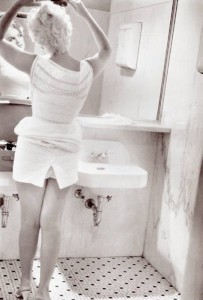
The Sad: The incredible photographer Eve Arnold has passed away.
The Ugly: Losing Ground on Women’s Rights: In 2011, Sex Ed, Contraception, Abortion Rights All Under Seige.
He Earned His Living Exhibiting His Nose
“Strange As It Seems” Thomas Wedders – Yorkshire, Wng. Earned His Living Exhibiting His Nose It was 7 Inches Long!
Well, you know what they say about men with large noses… So his nose was the only thing he could shows at the time. *wink*
Vintage comic drawing by John Hix, who created syndicated comic art oddity drawings similar to Ripley’s believe it or Not under the name “Strange as it Seems.” Via Grapefruit Moon Gallery.
See also: Wedders at Riplye’s.
Bike. Rack.
I’ve been so busy, I almost forgot to post this!
Photos taken of the HoDo, covered in bras, for the 3rd Annual Bras on Broadway, downtown Fargo.
Savage Me In The West
A further proof of my “Western’s are male romance novels” theory, I present Sexy Girl Cowboy, gouache artwork by Betoll, created as the cover for a Micro Mystery #173 (circa 1970s). At least everyone — from white cowgirl and cowboy to Native Americans — is at least a sexual savage. And I’ll be kind and not talk about his premature gun ejaculation. Via Grapefruit Moon Gallery.
Cheap Thrills Thursday: Breakfast Cereal Edition
Forget yer flashmobs; feed me the health and morality lessons via the kitschy art. Artist Ron English makes his statements about cereals in parody designs — Pop Art Krispies, Sugar Corn Popogandas, maybe? — and then places the boxes on store shelves. If you find a box, he’ll sign it for you. Personally, I have to ask where the Sugar Colon Pops are. (Via Geyser Of Awesome.)
Make Up For Breasts?
No offense to Mr. Vargas, but I think he misunderstood the task… This vintage ad was for “Twin Make Up,” not makeup for “the twins.”
The original artwork by Alberto Vargas goes up for sale at Heritage Auctions on September 30, 2011.
ALBERTO VARGAS (American, 1896-1982)
New Jergens Twin Make-Up, advertisement poster, 1943
Mixed media on board
18 x 14 in.
Signed upper left
Big-Eyed Art Is Sexy
Big or sad-eyed art was sexy enough for this vintage pinup photo-shoot. My thoughts on this are rather covered here. (Image via.)
The Breast Drawing Advice: How To Draw Boobs Without Being A Boob
We all know comic book art, pinups, and many other art forms exaggerate the human form; especially the female form. However, if you want any sort of realism at all — let alone to avoid complaints about body image, statements that comic book nerds have never seen nude chicks, etc. — check out this illustrated tutorial by Ovens (aka Unconventional oven), of Effort Comics (18+ webcomic):
In case you don’t have a pair of your own, haven’t ever seen naked boobs before, or simply forget about physics, this is an excellent reminder. It also pleases me as it points out that our female finer points move, are affected by position & gravity, may not point at all, and may even sag — all of which is natural and beautiful.
I say, exaggerate away, artists, as long as you get the most simple basics of flesh and physics right.
See also: The seventh in the I Draw the Line series by Tom Nguyen. (Sadly, this archive of the series is sans illustrations.) In his “how to draw boobs” entry, Nguyen provides the ultimate artistic breast advice:
Boobs have a general shape, yes, but keep in mind that they are soft and have weight. Therefore, their shape changes to work with gravity and clothing.
Archimedes Screw – You
One of my favorite altered art works; you can buy a poster copy, if’n ya wanna.
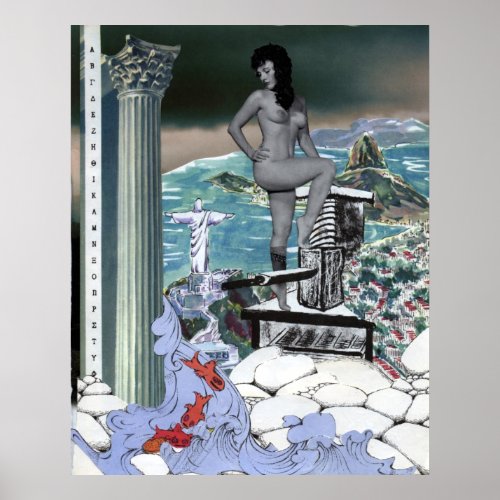
Do Women Have To Be Naked To Get Into U.S. Art Museums?
Made by the Guerrilla Girls; found at Experimentations Of A Teenage Feminist.
Art Therapy For Break-Ups
This is either called Fuckface the Fucknificent or You & Your Ugly Heart by Collin David, who I just interviewed here.
Little Jumping Joan
I always found this nursery rhyme a little unnerving…
Little Jumping Joan
Here am I, little jumping Joan,
When nobody’s with me
I’m always alone.
Apparently photographer Jonathan Hobin thinks so too; this is Jumping Joan, a little girl wearing a straightjacket, from his Mother Goose series.
